¶ Joining To Meeting
User can join the meeting using the gloCOM Meeting web application. Link to the app is: gloCOM Meeting Web App
Be aware that the web app supports only the join meeting part, not creating the meeting.
Once the user has entered the page, they will be greeted with the following Join Meeting screen
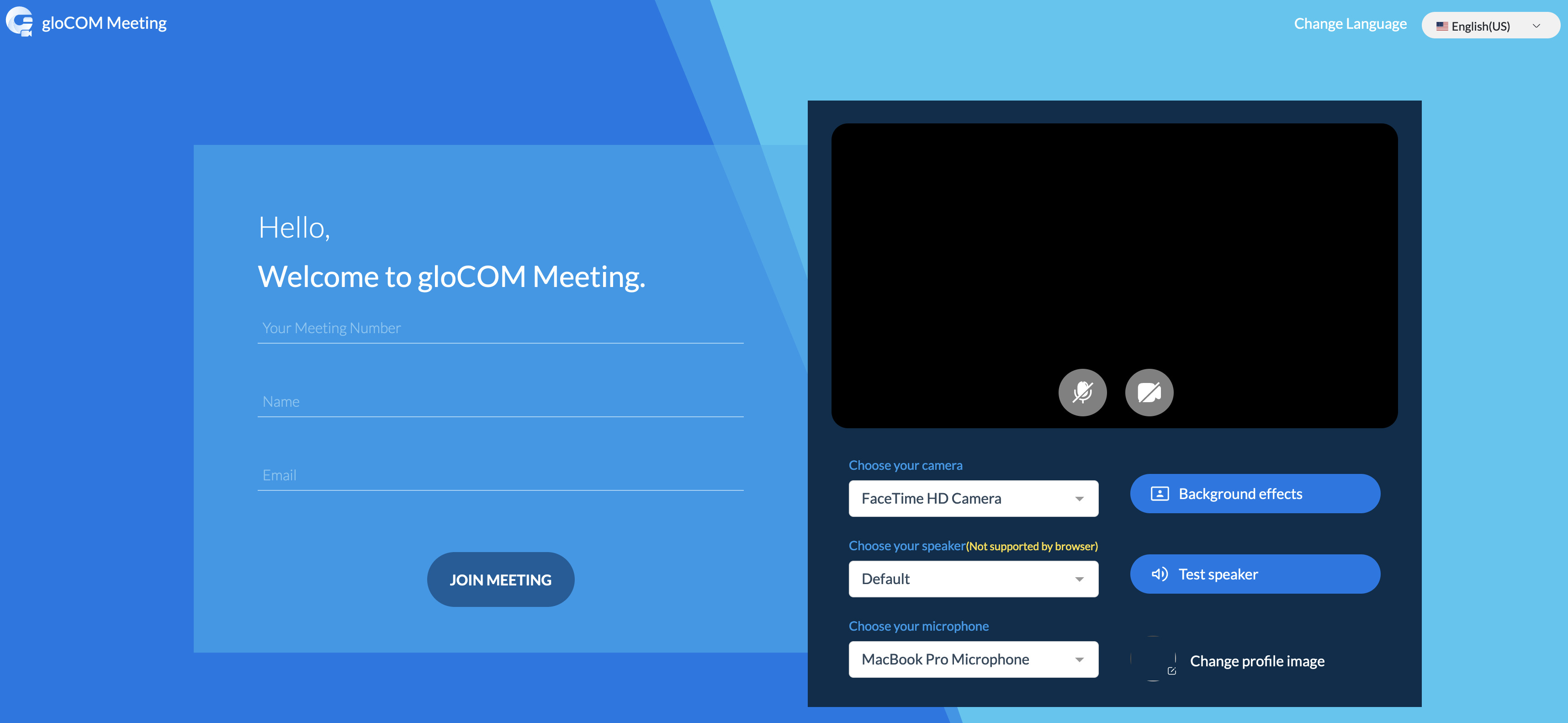
On the left side is the Login data section, while the right side displays the audio and video settings to be used during the meeting. In the upper right corner, users can select their preferred application language. Supported languages include English (US), French, Italian, Portuguese (Brazilian), German, and Spanish.
Before switching to explanation of main options here, there will be given basic information about permissions that should be granted in order to use the Meeting web app.
¶ Granting necessary permissions
Meeting web app needs permission to:
- Camera for video communication.
- Microphone for audio communication
- Screen Recording and Accessibility for screen sharing and remote control
The user can enable these options as follows:
- Google chrome web browser by going to: Settings → Privacy and Security → Site settings → Permissions → Camera/Microphone → meeting.bicomsystems.com
- Safari web browser by going to: Preferences → Websites → Camera/Microphone → meeting.bicomsystems.com
- Firefox web browser by going to: Preferences → Privacy and Security → Permissions → Camera/Microphone → meeting.bicomsystems.com
- Edge web browser by going to: Settings → Cookies and Site Permissions → Camera/Microphone → meeting.bicomsystems.com
If the necessary permissions for camera and/or microphone have not been granted, the user will see a dialogue box asking them to grant the permissions:


There is an option to enable camera and microphone on the web browser quickly:
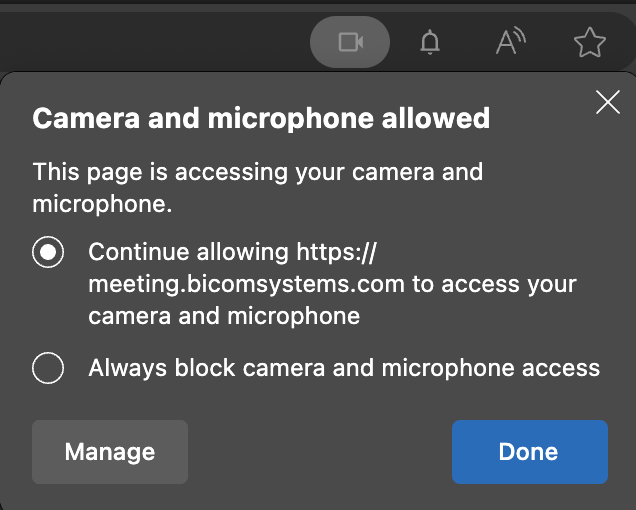
¶ Login data
After user provided all necessary permission regarding audio and video outputs, the next step is to enter following login informations:
- Your meeting number - number of the meeting provided to the user by the meeting organizer
- Name - represents the name which will be used for a user in the meeting
- Email - user's email adress
Your Meeting Number and Email are used for authorization purposes.
Meetings can be private or public. For private meetings the user needs to be invited by an email to be eligible to join the meeting. For public meetings the user doesn’t need to be invited, which means that email can be arbitrary.
After filling in the fields with the required information, the user can also change their avatar (profile image) if desired. This can be done by clicking on the Change profile image button which allows user to upload a photo from their device. Then, the Join Meeting button should be pressed to join the meeting. Meeting data authorization will follow. If a public meeting exists, or the user is invited to a private meeting, the authorization will be successful, and the user will join the meeting. All services will be joined automatically as well.
If the authorization is unsuccessful, the user will be redirected back to the join screen, and a message will appear informing them that the join details are incorrect:
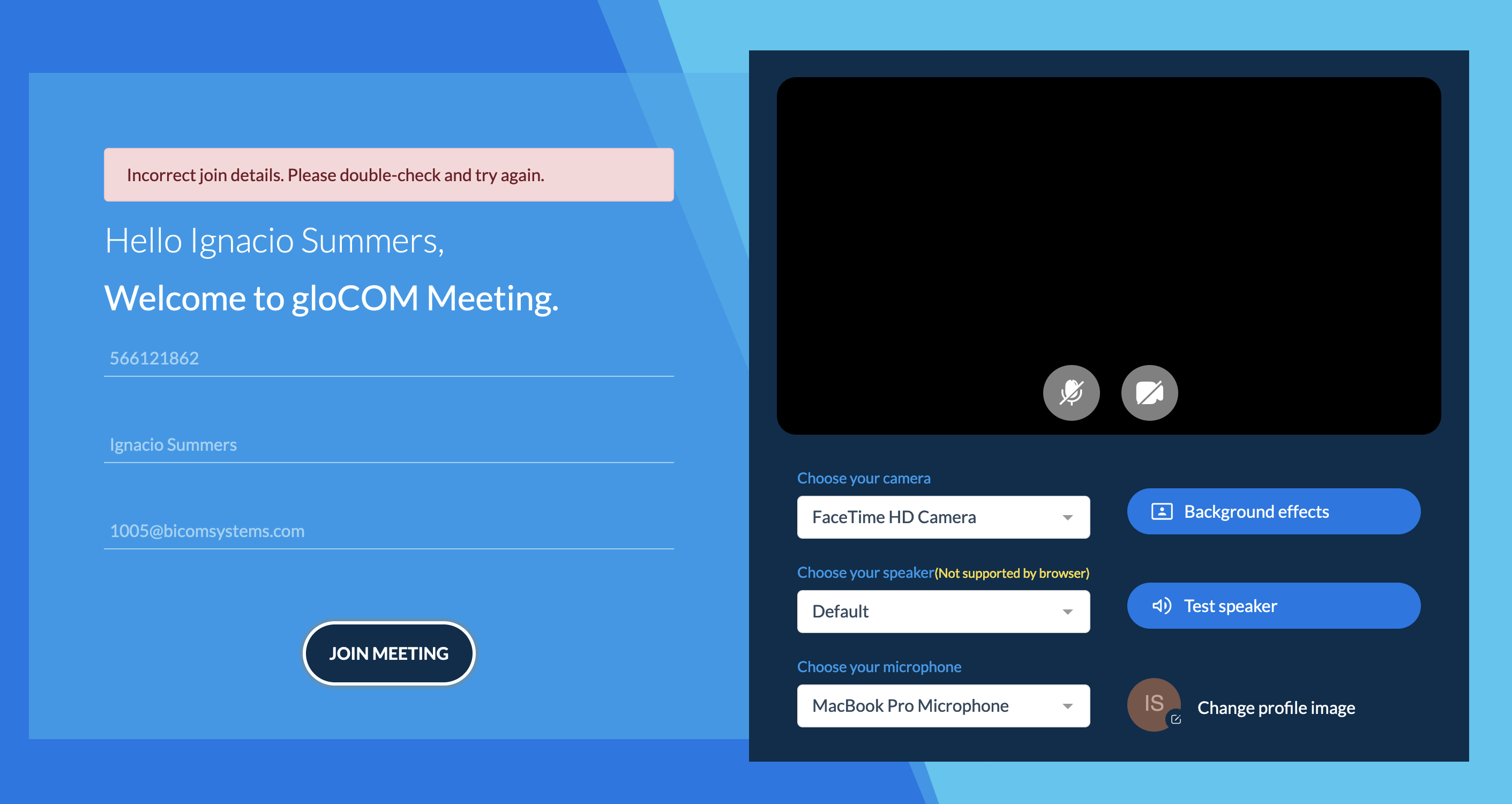
If the user is distributed a direct link to the meeting, the user will already have the meeting number filled in when accessing the page. If user was joining meeting via web app before, name, email and avatar will also be filled out:
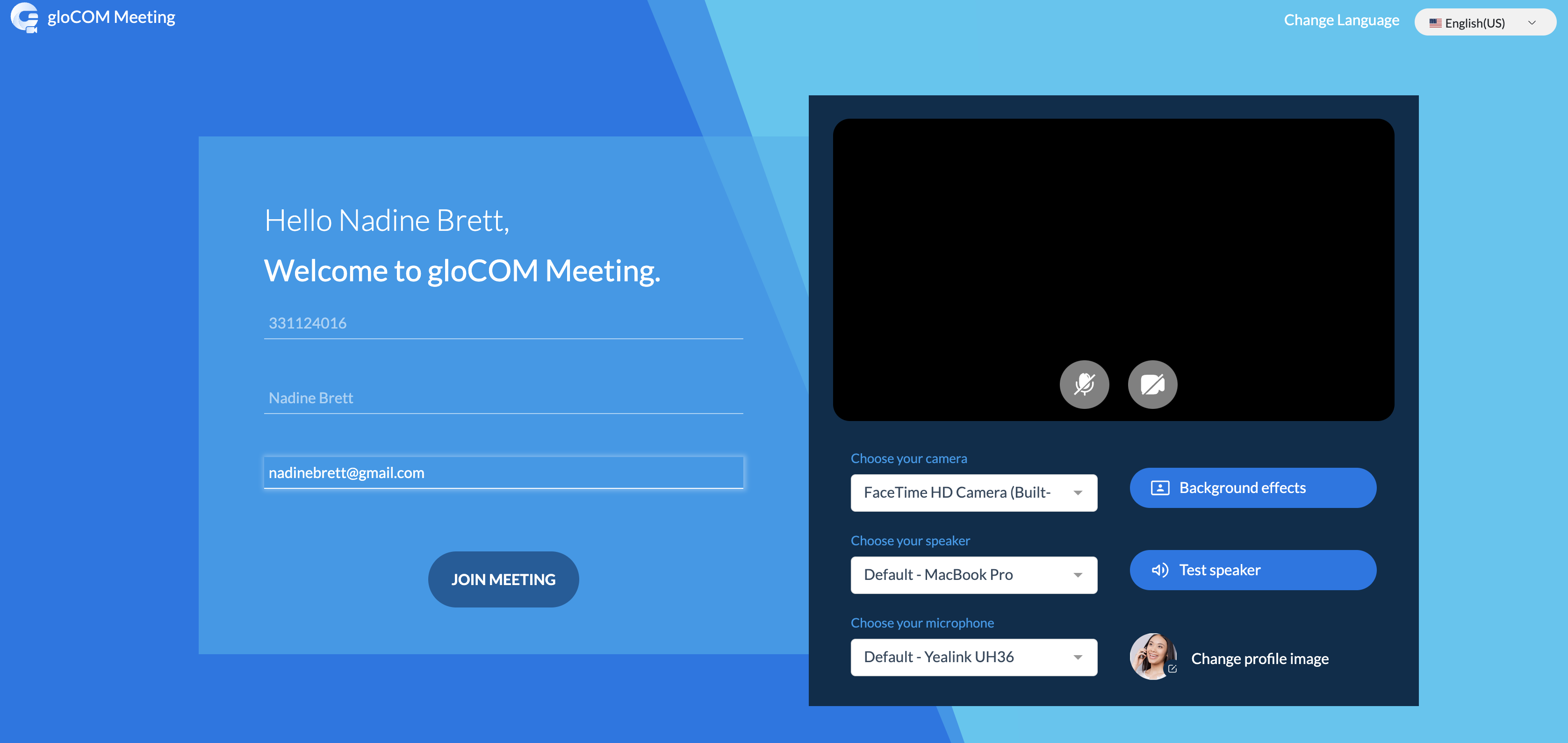
¶ Audio and video settings
On the right side of the screen user can setup audio and video meeting settings:
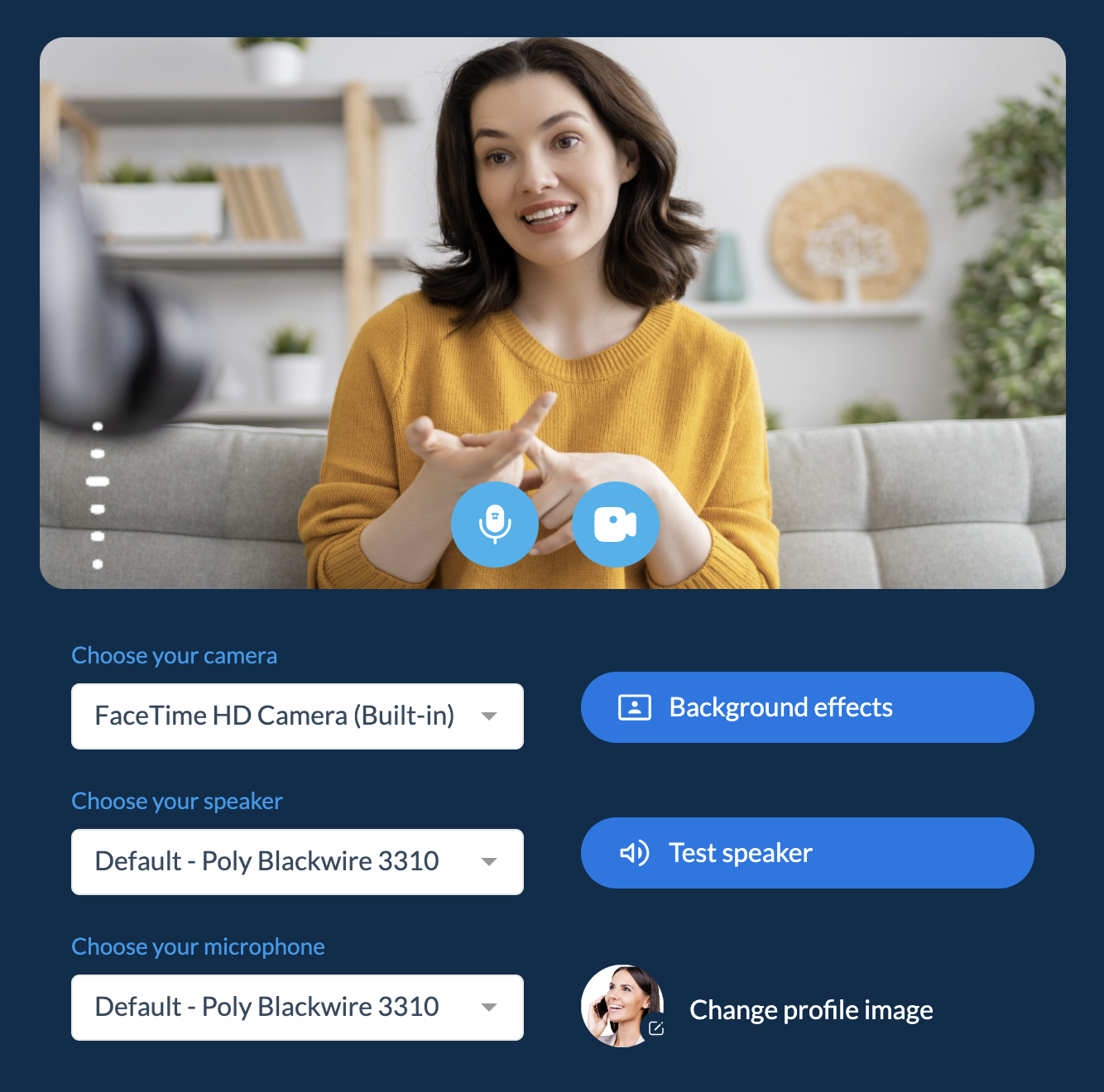
Following microphone and camera settings will be used when the user joins the meeting:
![]()
- Mute/unmute your own microphone will disable/enable the audio coming from users device
- Turn on or off the camera will disable/enable your own video users camera
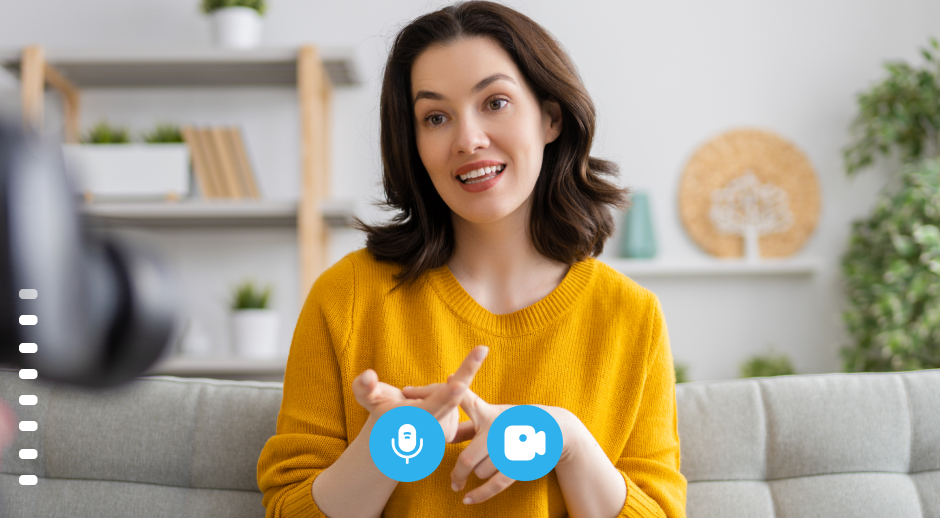
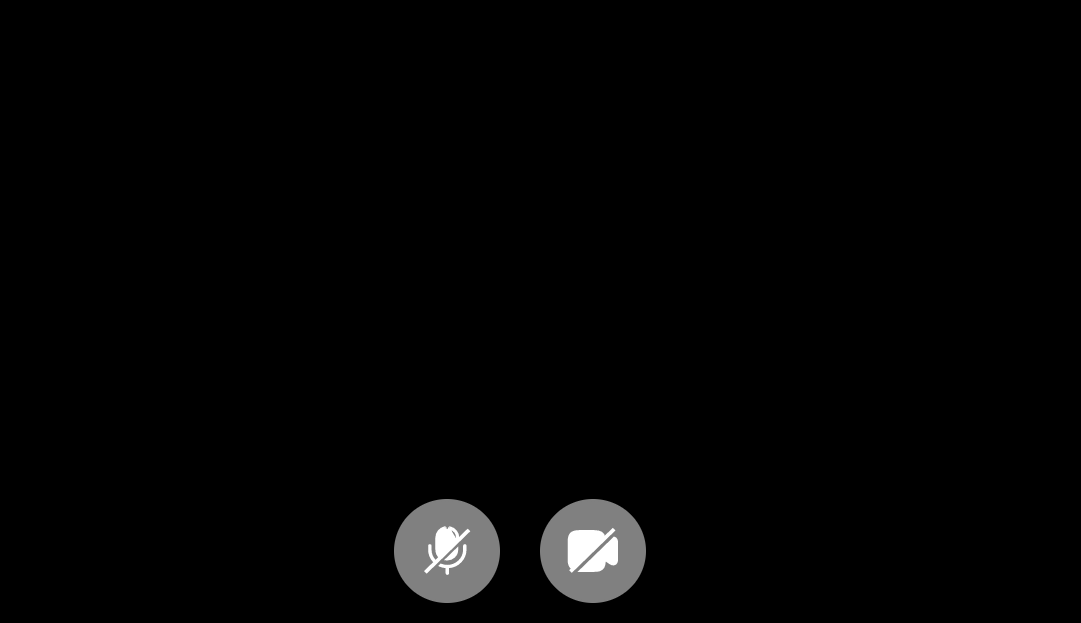
Further settings allows user to set up devices, background effects, etc:
Choose your video device allows the user to choose which video device will be used during the meeting. Select device from the drop down list.
Choose your output device allows the user to choose which audio output device will be used during the meeting. Select device from the drop down list.
Choose your input device allows the user to choose which audio input device will be used during the meeting. Select device from the drop down list.
Background effects allows the user to mask their background. By clicking on the button, a new screen will appear offering different options for background effects, including loading your new picture that can be used for background. User can also set background after joining a meeting by clicking Video arrow > Background Effects.
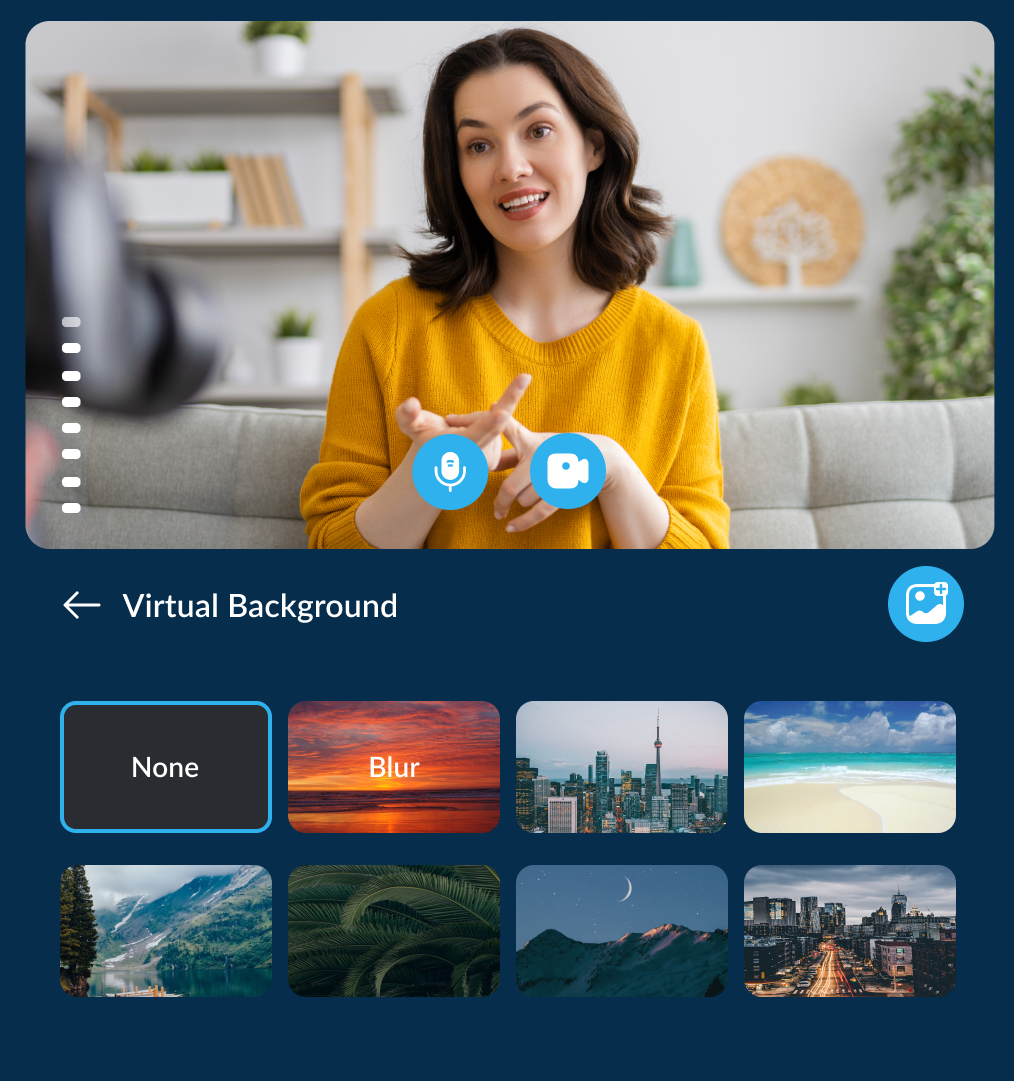
Test speaker will play a sound to the user to make sure they are using the correct audio output device.
Remember my setup allows the user to keep these settings for the next time they use gloCOM Meeting by checking it.
¶ Meeting interface
Once the user set up all audio and video settings, and filled out all necessary and correct login information, they will have been successfully joined in the meeting. Meeting interface appears with the meeting window and toolbar at the bottom of the window.
Default view when the user joins the meeting is Speaker view:
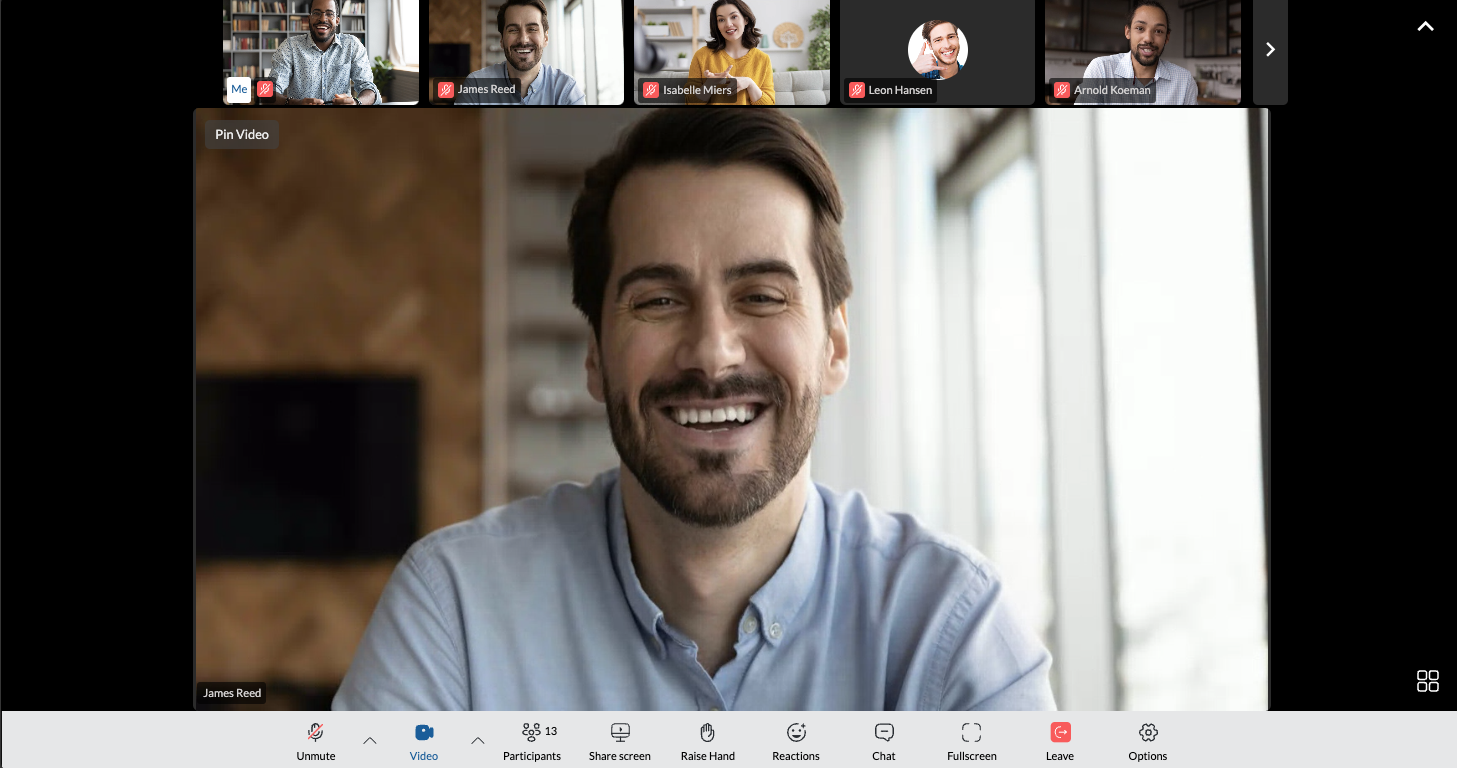
¶ Grid/Speaker view
![]()
The user is able to change their view of the participants, they can either use the grid or speaker view. The grid view will show more participants in a grid fashion, while the speaker view will put the focus on one of the participants. The button to switch between Speaker and Grid mode is located in the bottom right corner.
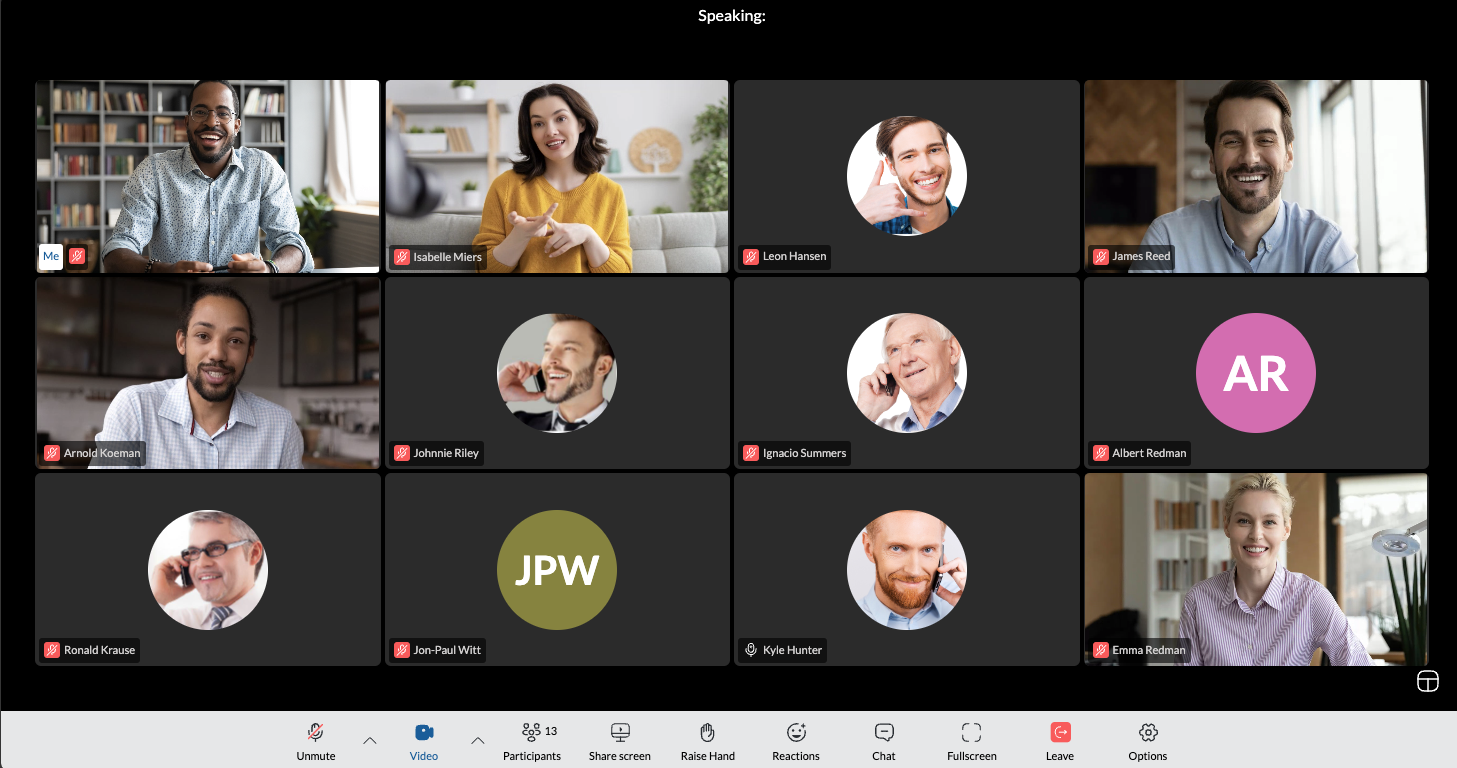
¶ Hide/Show carousel
While in speaker mode, the user has the option to hide the participants at the top to give a clearer view of the speaker. The button is located in the top right corner.
![]()
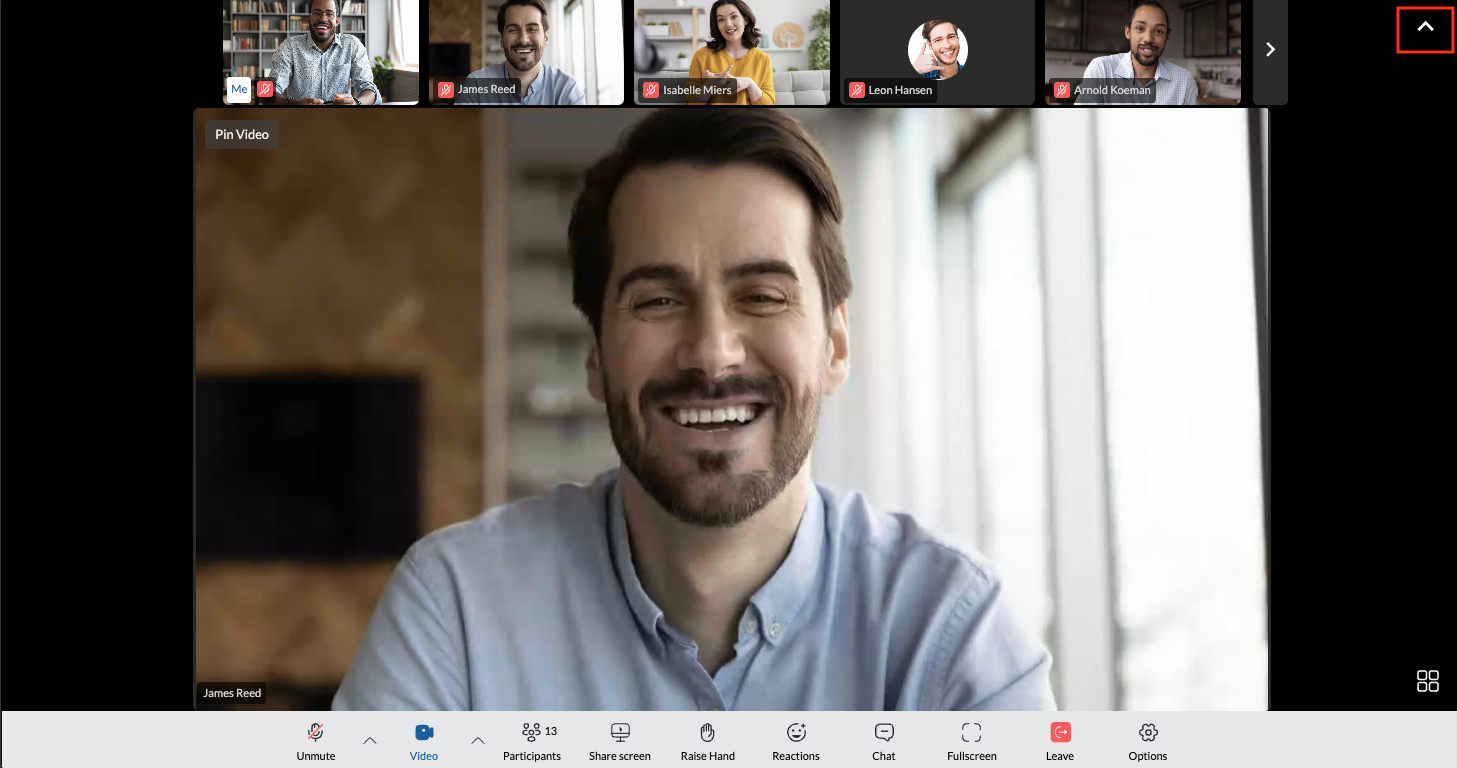
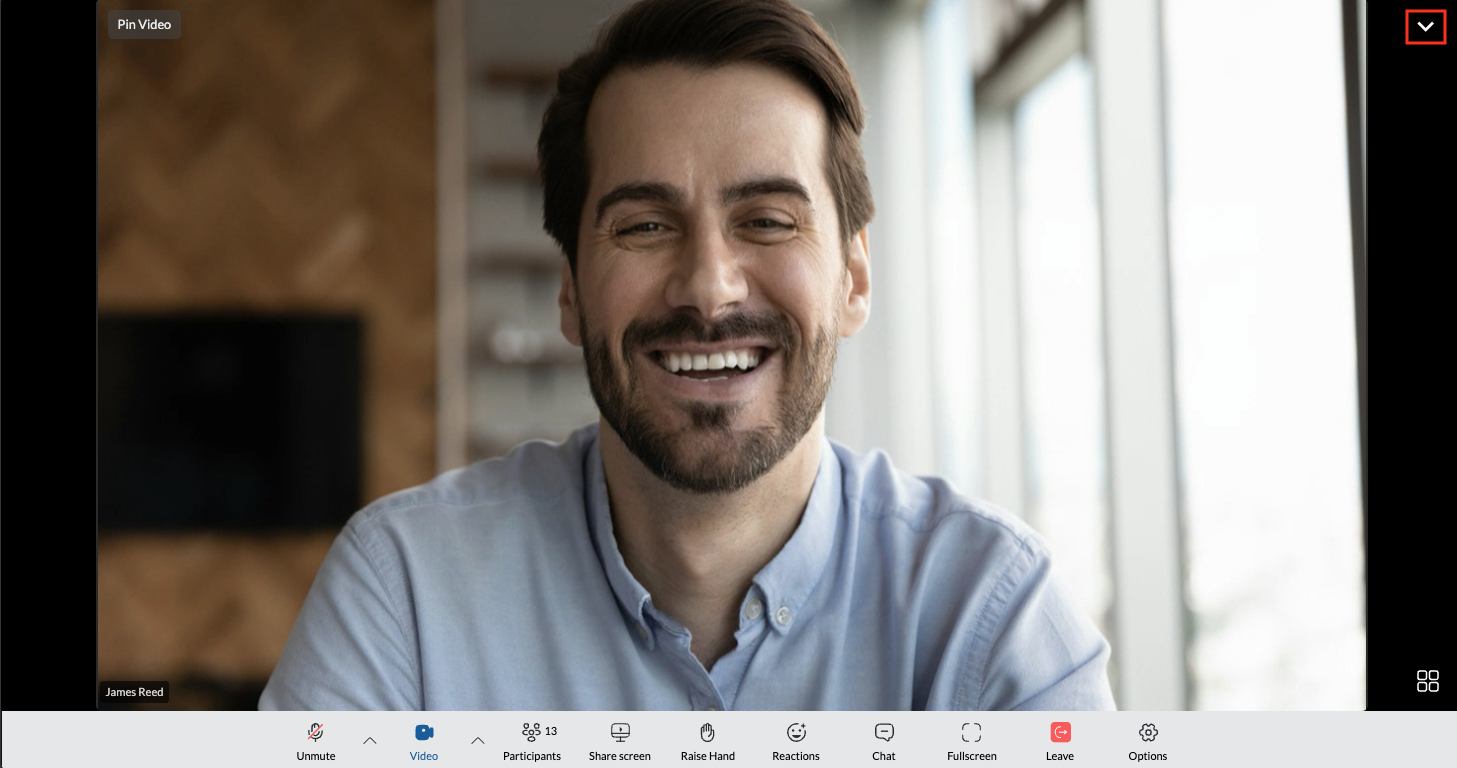
¶ Pin/Unpin video
If the user is in Speaker view the user can pin a participant to make that participant's video the primary video.
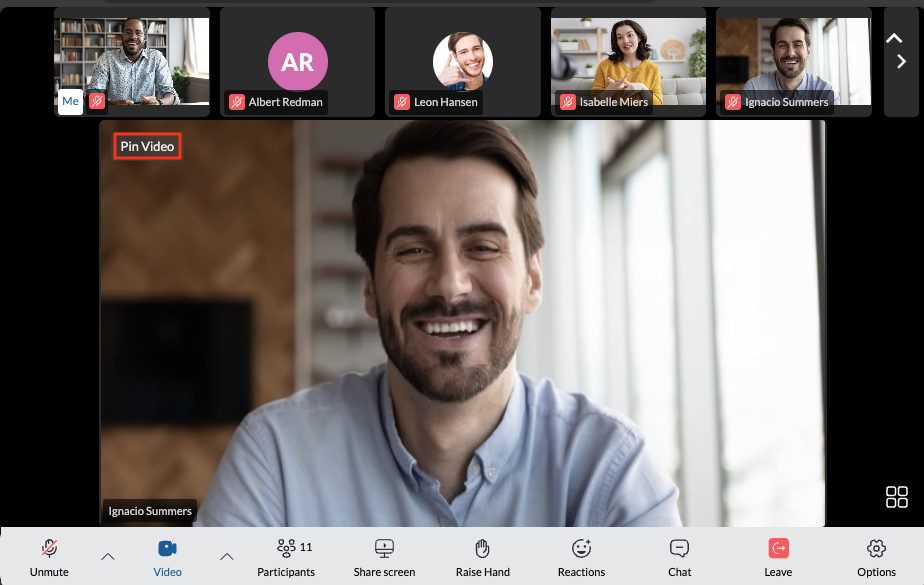
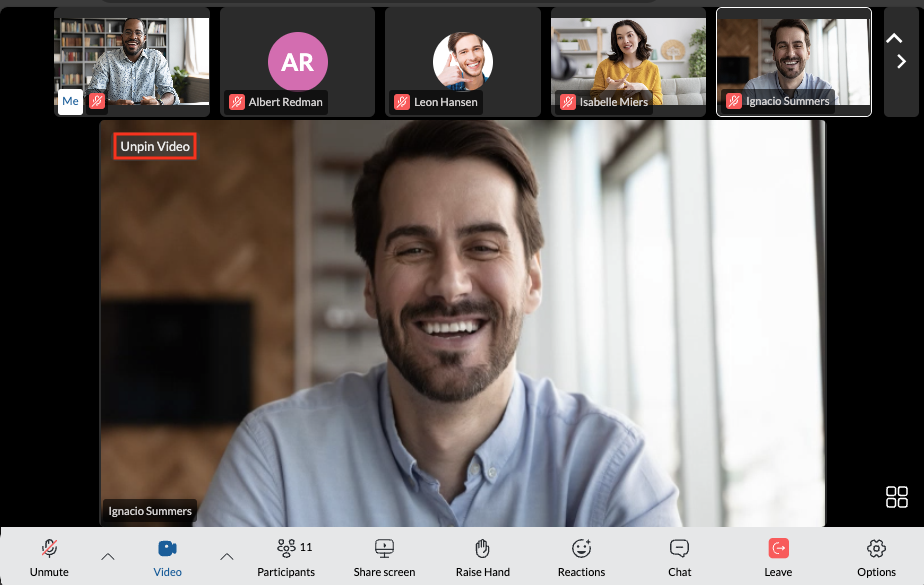
¶ Highlight Speaker
If a participant is talking, the user will be able to see that there is a moving icon in their participant bubble
¶ List all video participants in grid/speaker view
List all video participants in grid or speaker view using arrows:
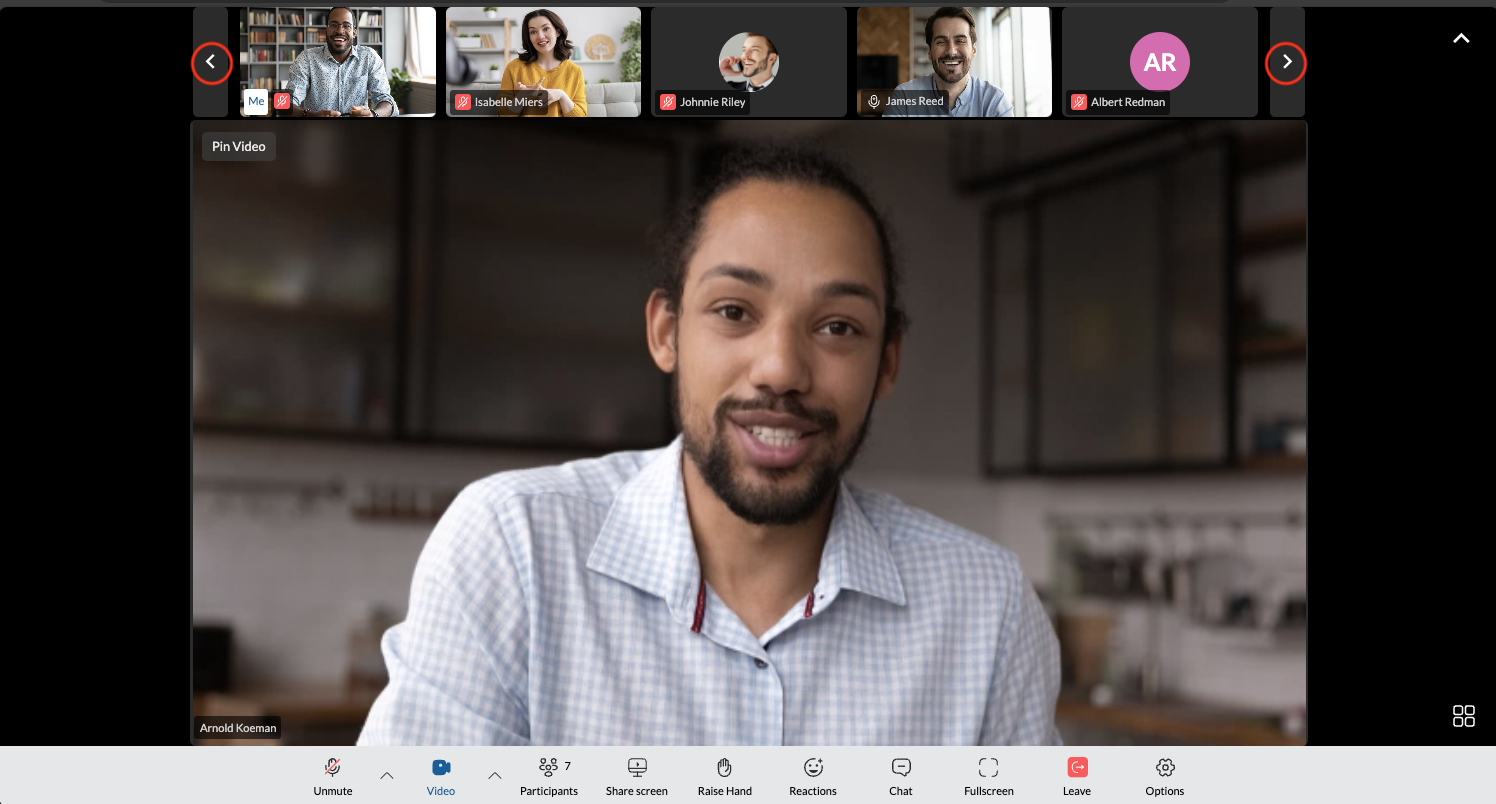
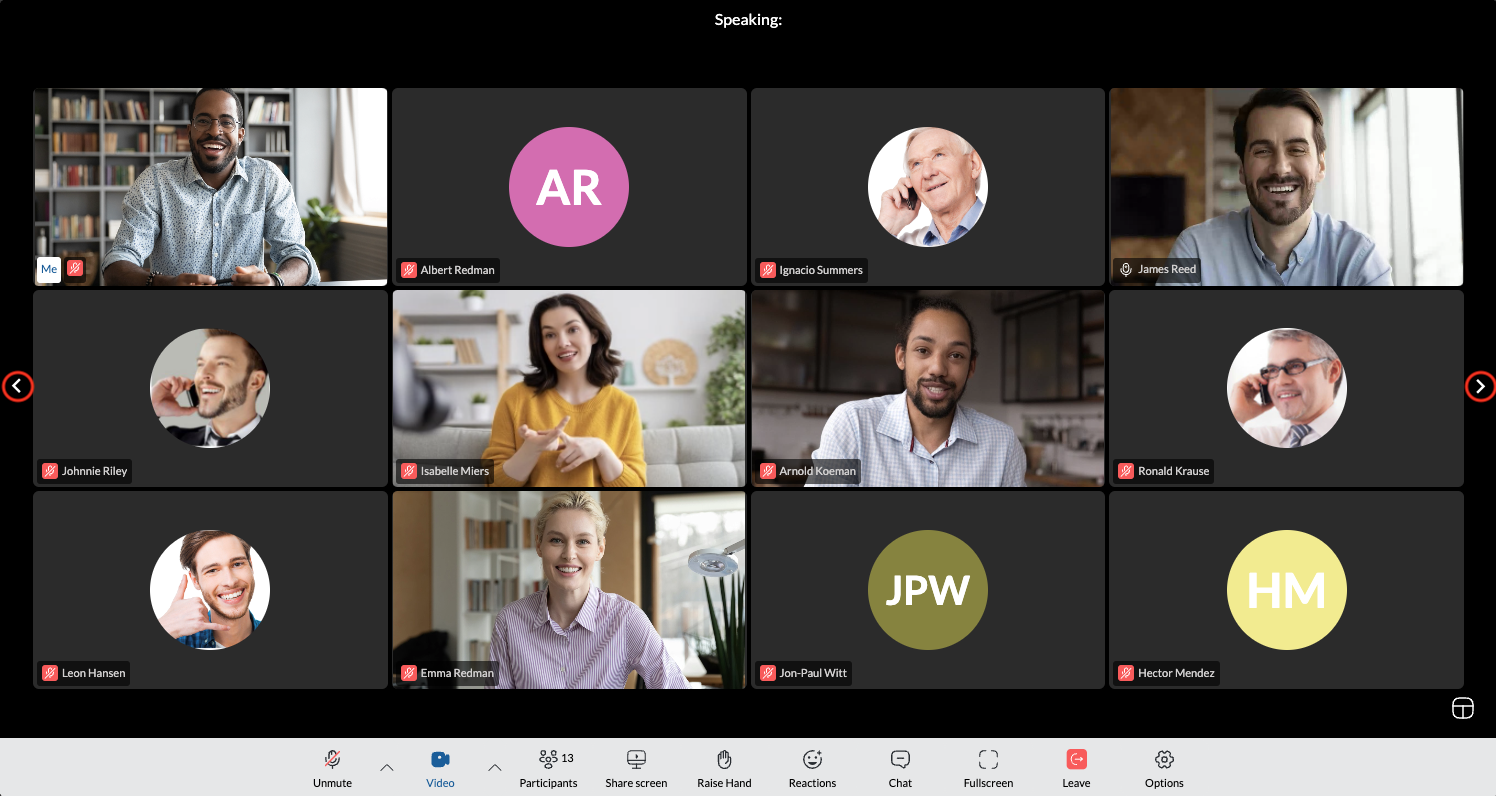
Me video stream is always pinned to first positon.
¶ Grid view size
The grid view in the meeting will automatically change the number of video streams based on the number of participants in the meeting.
It follows the following conditions:
- Up to 45 participants = grid size 12 (user + 11)
- 46 - 60 participants = grid size 9 (user + 8)
- Over 60 participants = grid size 6 (user + 5)
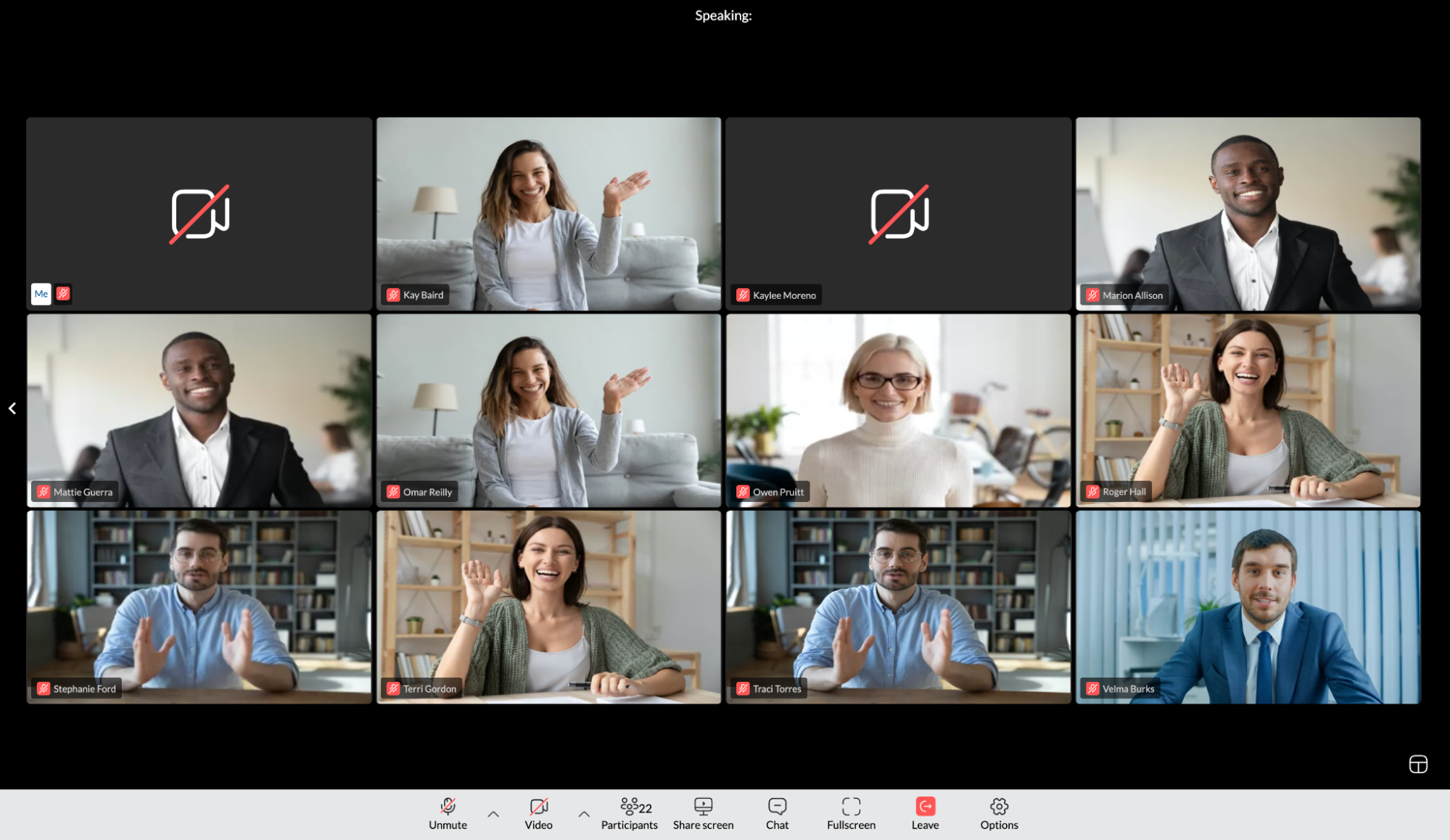
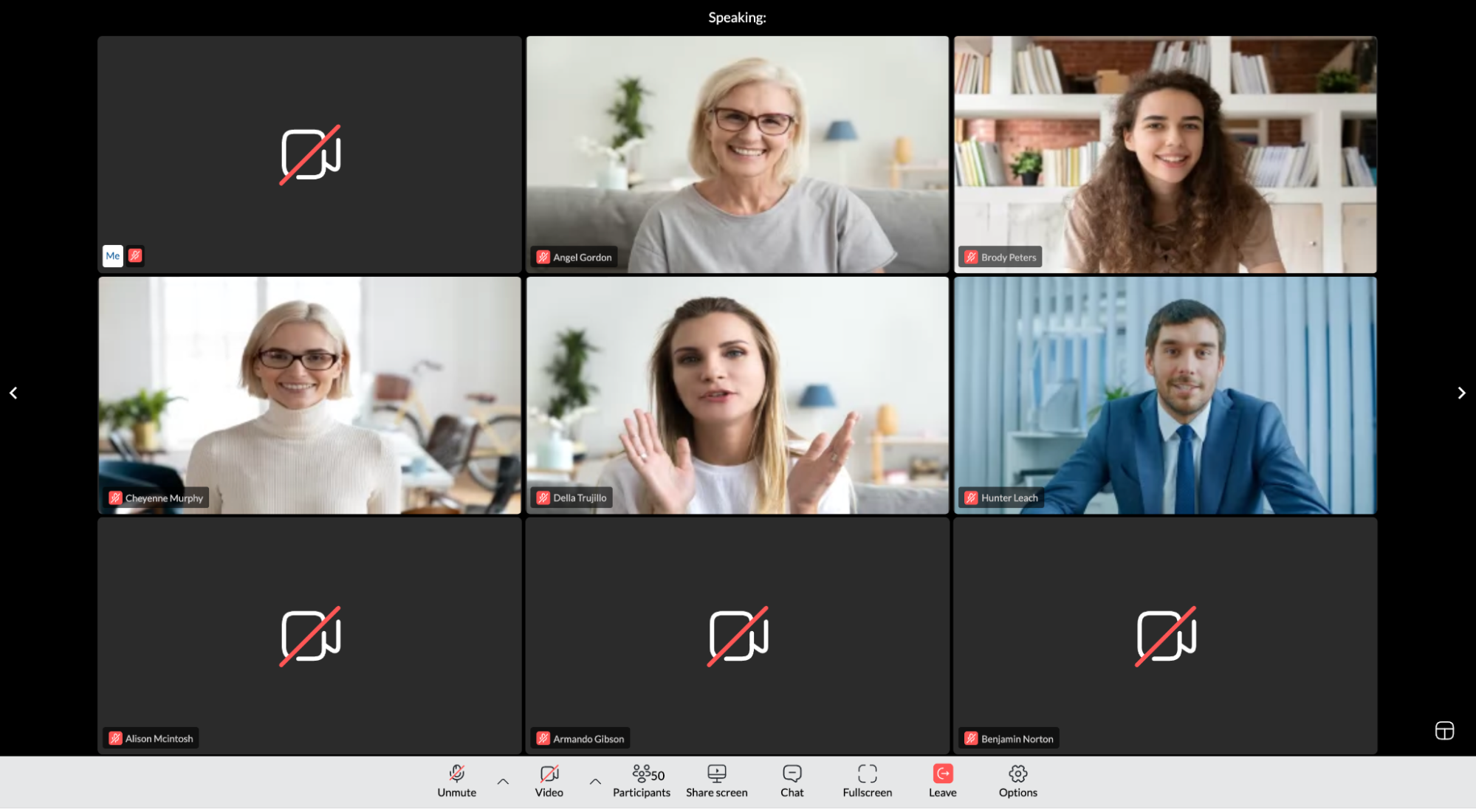
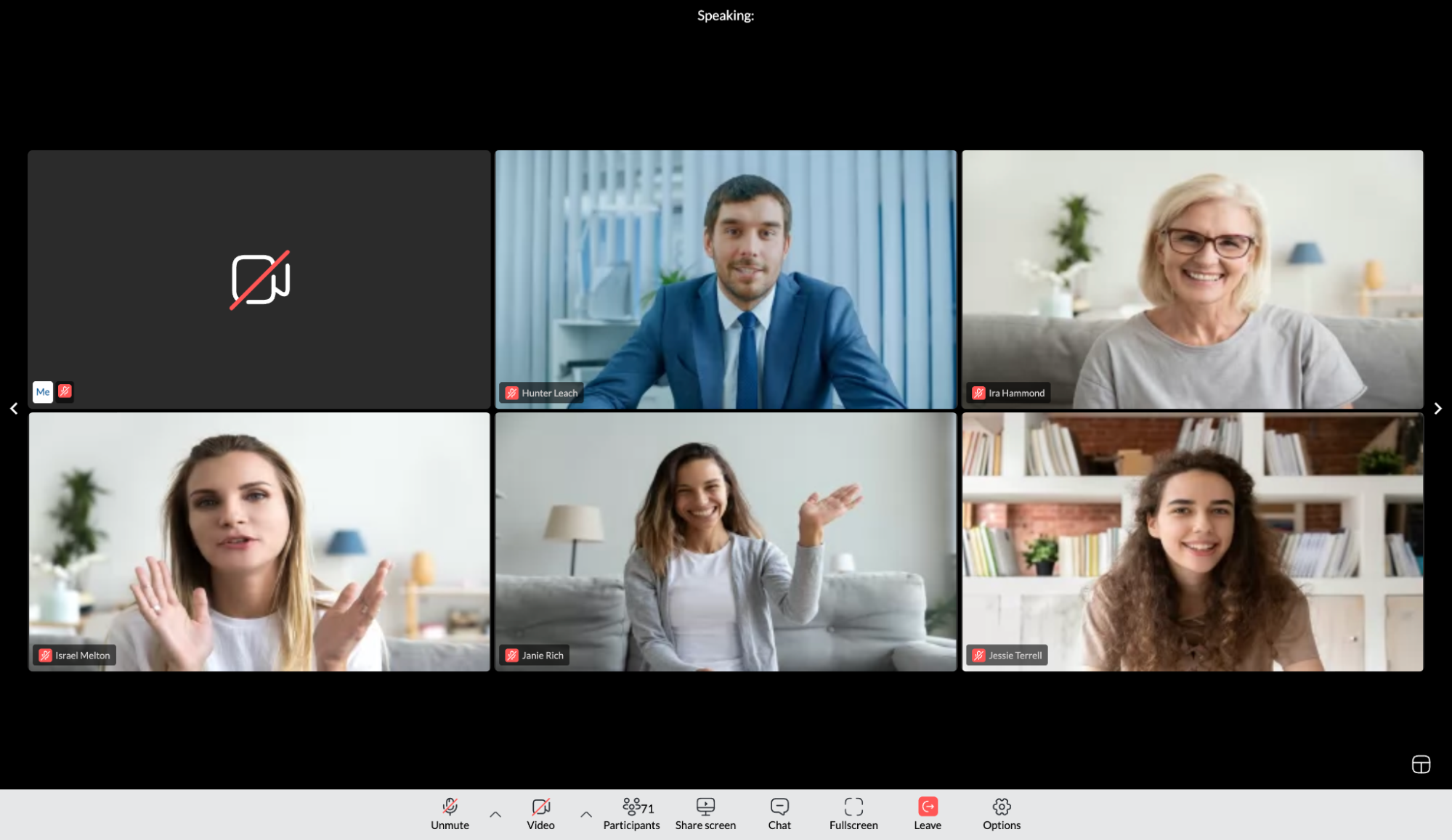
¶ Meeting toolbar
Default meeting toolbar (without screen sharing started) looks this way:

¶ Mute/Unmute
![]()
Once a participant has joined the audio of the meeting they can freely mute or unmute themself by clicking on the mute/unmute icon. The current state is one that is displayed in the user’s toolbar. There is also the option to switch between audio devices or to enable/disable a noise suppresion if the user clicks on the up arrow next to the mute/unmute button.
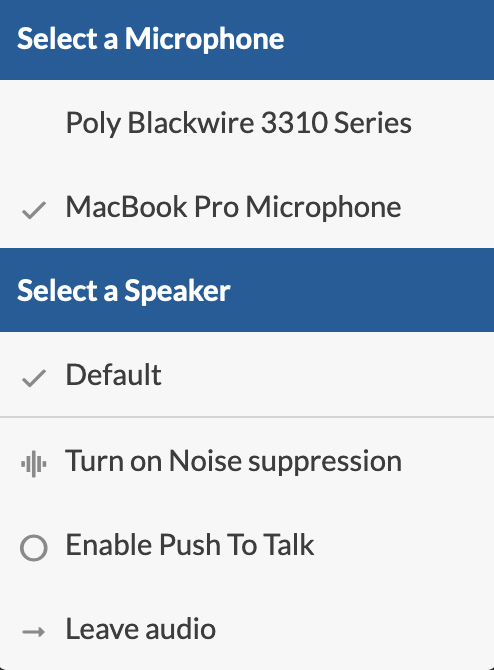
¶ Video sharing
![]()
A participant can enable video sharing if they have a video capturing device connected to their computer. They can enable or disable the device in the meeting at any point by clicking on the video icon.
The user can also change their video device if they click on the upwards pointing arrow to the right of the button.
The user can also enable “background effects” here as well.
¶ Participants
![]()
The user can view the list of the people invited in the meeting. The button will also display the number of participants in the meeting. Invited participants who have not yet joined the meeting will be displayed by their email address. Participants who have left the meeting will be shown with their name, along with their avatar if they had one. If the participant was an organizer or co-organizer, the corresponding label will be added. All non-present participants will have a "Not Present" label, and there will be no audio or video icons next to their names. Once a participant joins the meeting, the label is removed, and the audio and video icons appear.
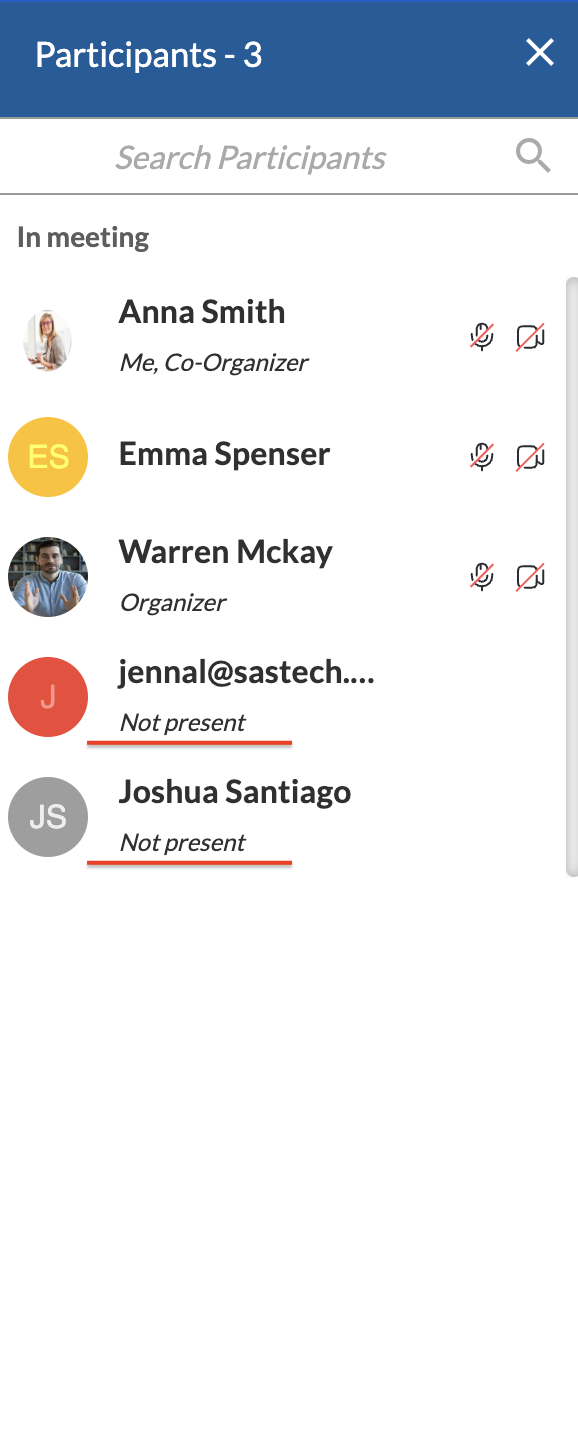
¶ Share screen
![]()
The user can press this button to share their screen with the other participants in the meeting. The user will have the option to share either:
- Their entire screen
- A specific window
- A tab from their browser
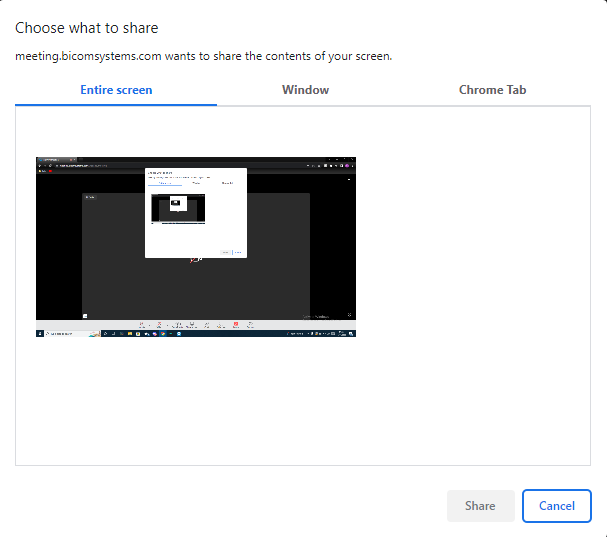
When the user presses the button to share their screen, other participants will initially see a label indicating that screen sharing is starting, along with the presenter's name, instead of a black screen.
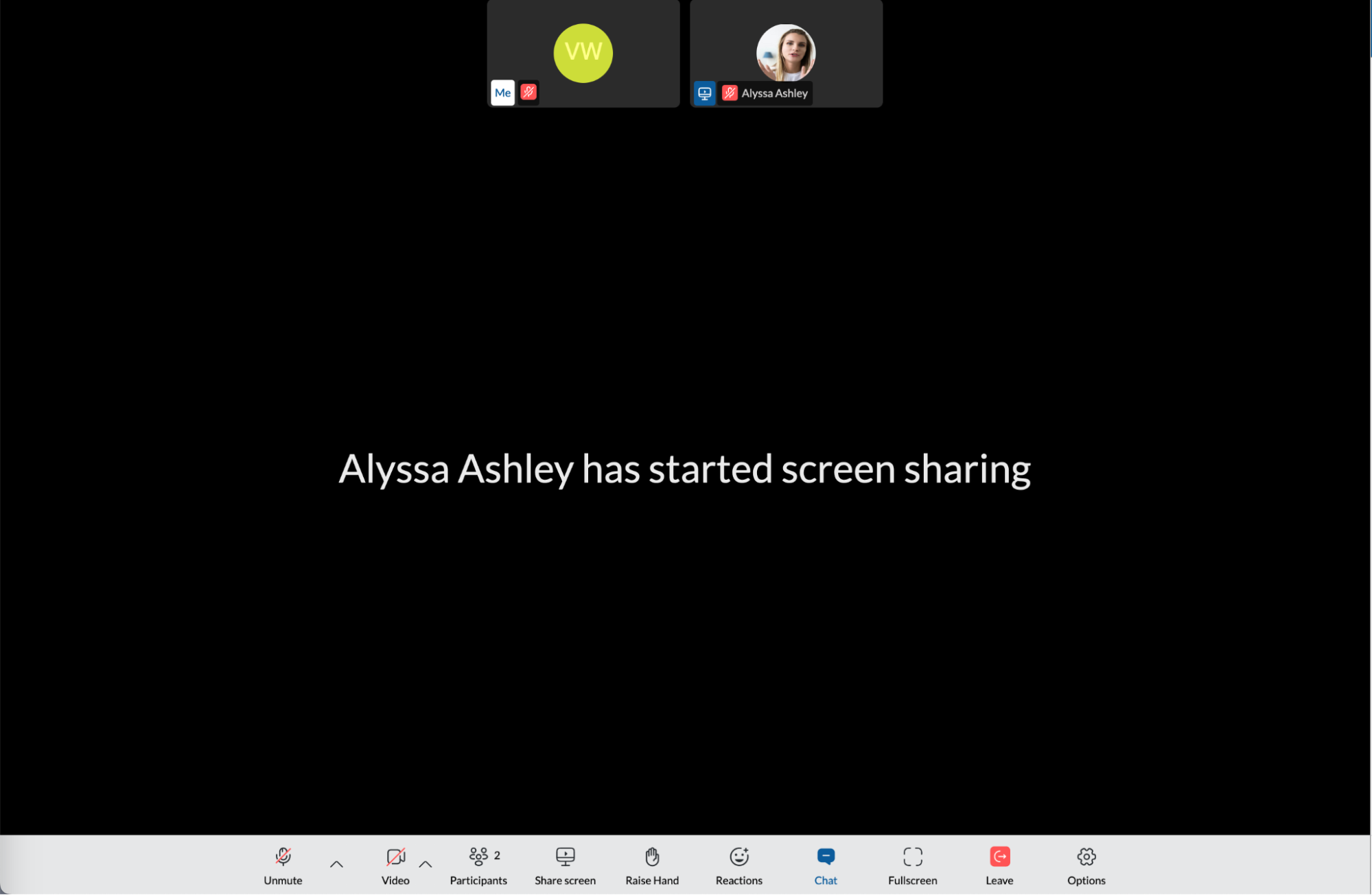
Presenters will also receive a notification in the upper left corner of the gloCOM Meeting web app, confirming that participants can see the shared screen. This helps reduce the need for presenters to ask if their screen is visible during the meeting.
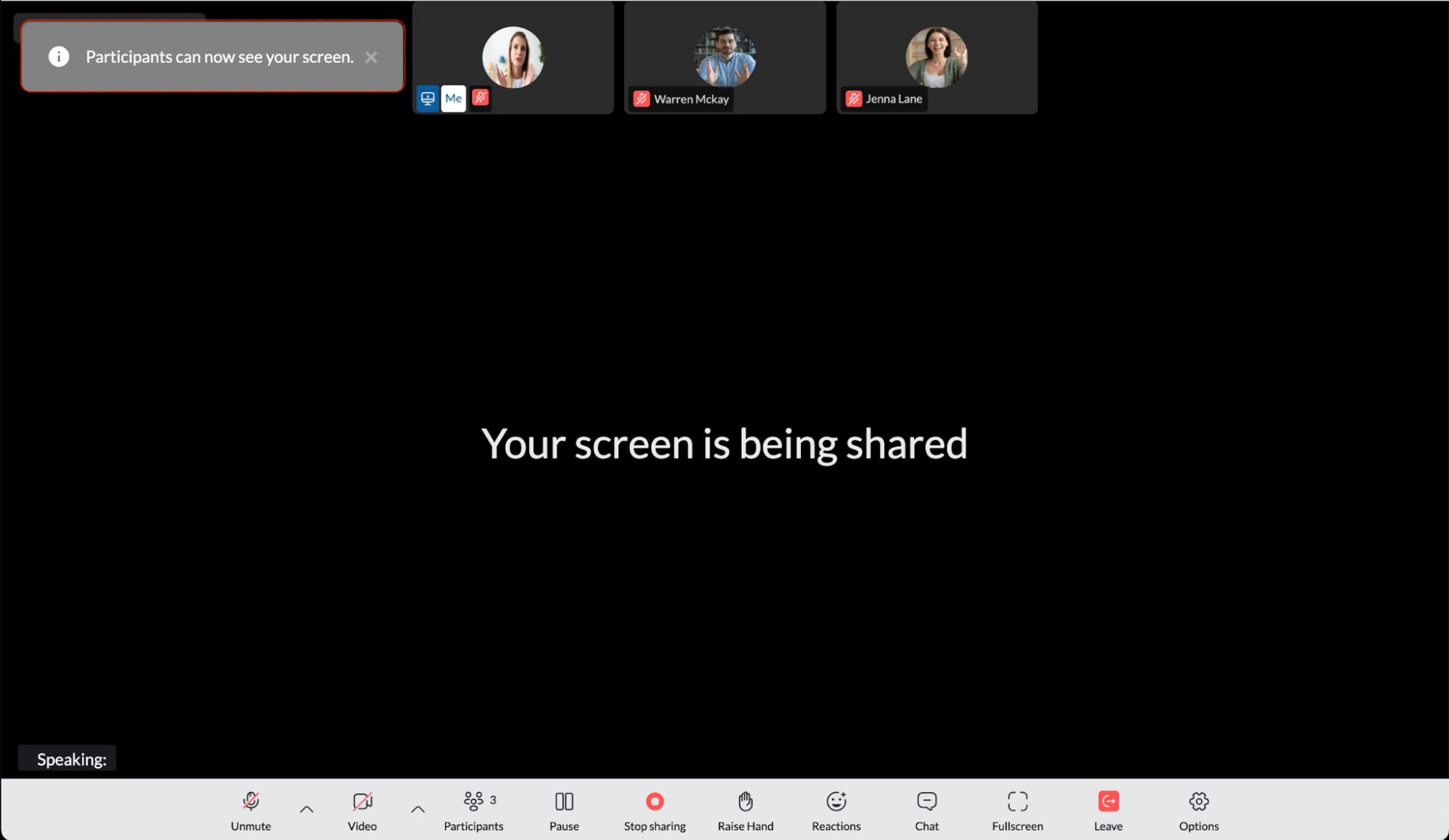
Once user starts sharing a screen the meeting toolbar will change to have a Pause and Stop sharing button:

If user clicks Pause screen sharing, then meeting toolbar will add new button for Resume sharing option:

While screen sharing is paused, the viewers will be provided with a clear notification that the screen sharing is paused. This will improve communication and prevent confusion during meetings.
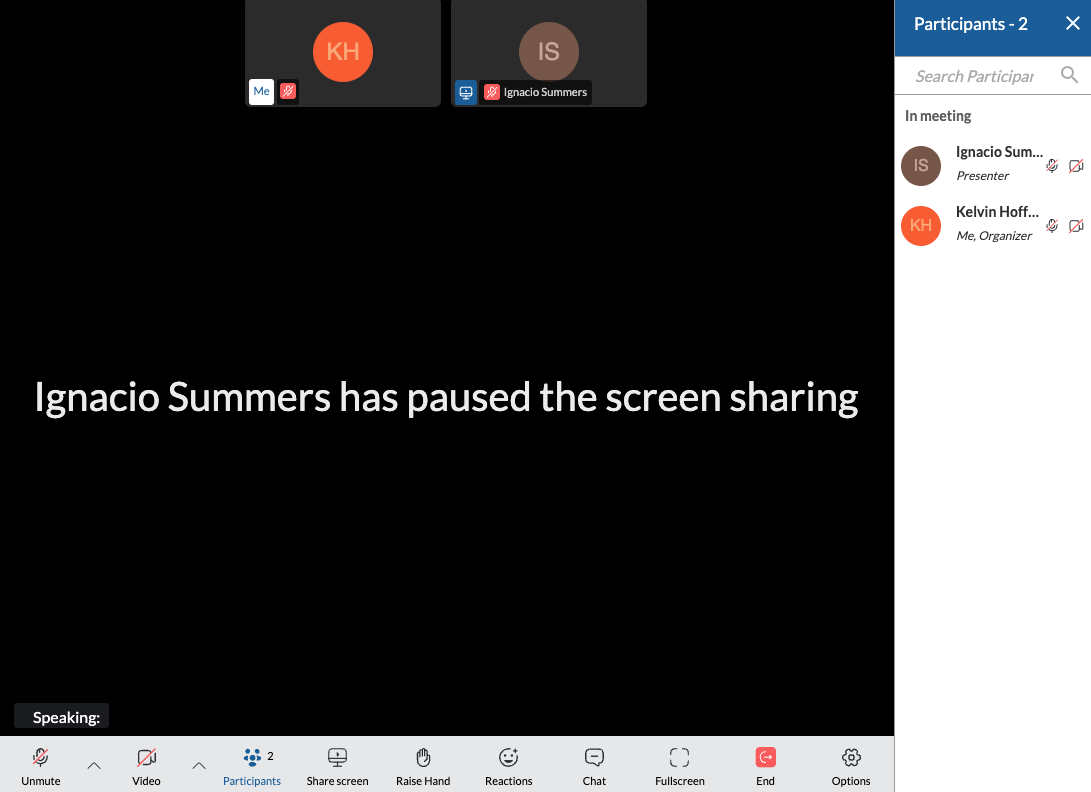
Also user is allowed to enable/disable screen sharing preview in web application while sharing screen using button for it in the top left corner:
By default, when user start screen sharing, Screen sharing preview is enabled:
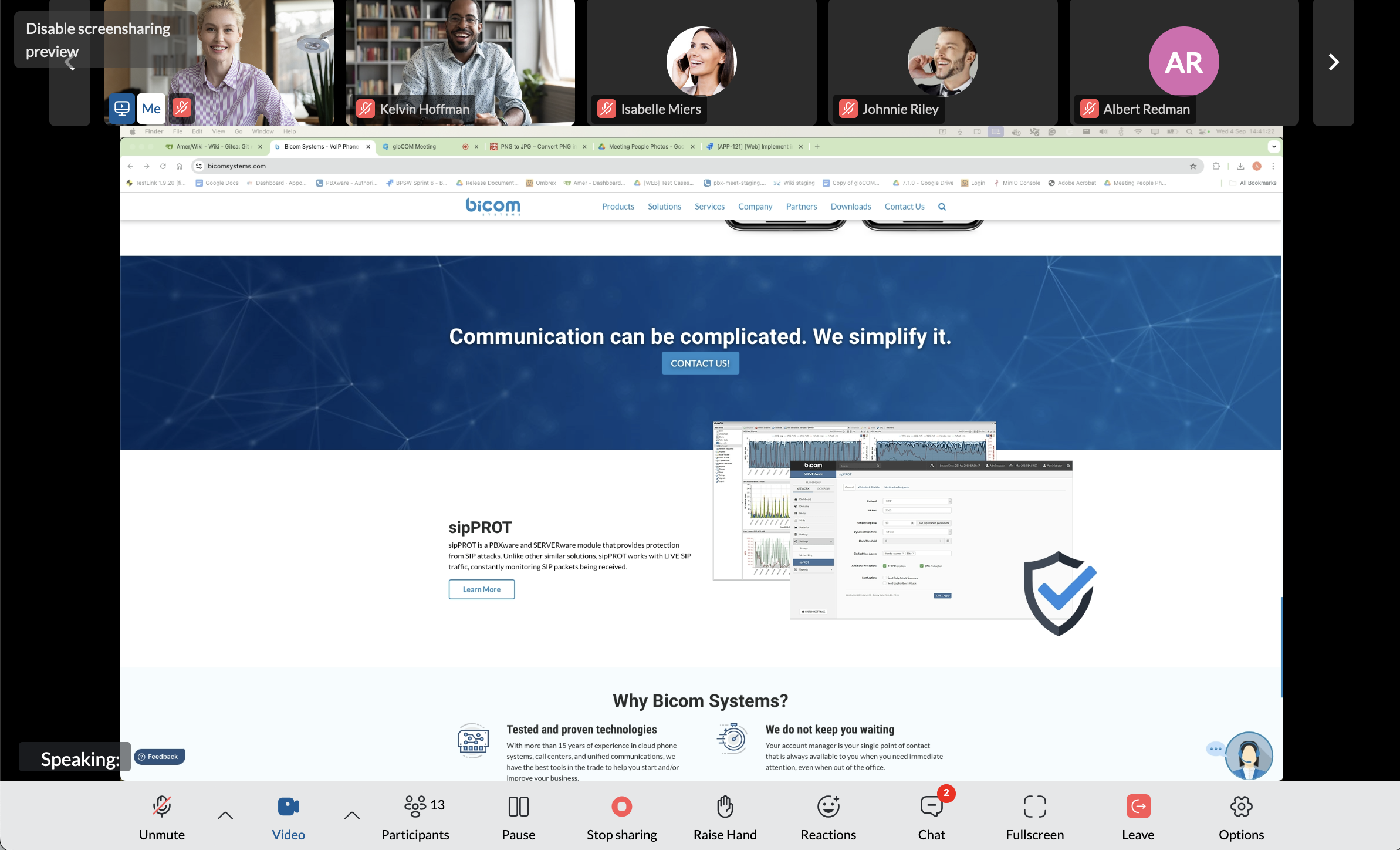
Additionally, if user shares web browser tab, this message appears on shared tab informing user that tab is shared, and also giving user direct link for meeting web browser tab for easier switching and coordinating tabs:
![]()
¶ Clipboard Sharing
Google Chrome web browser
This feature allows web users to copy the current clipboard text while using remote control in a gloCOM meeting and paste it on the remote-controlled host. Clipboard sharing is available in screen-sharing mode and can be enabled or disabled only from the desktop application, but it can be used from both desktop and web applications.

To enable this option, the presenter on the desktop application should grant remote control and enable clipboard sharing for web users. Afterward, the web user will receive a notification that remote control is enabled. The web user can then copy text to their clipboard and paste it on the presenter’s side using the remote control.
When using this option in a web browser for the first time, the user will be asked to grant the necessary permissions.
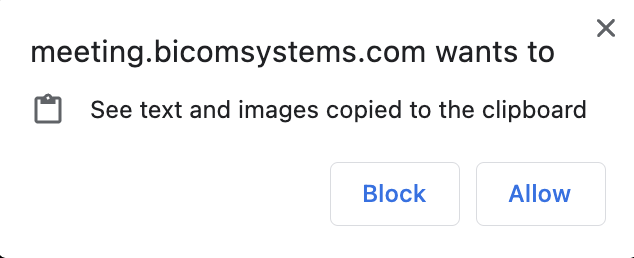
Safari web browser
The Safari web browser handles clipboard sharing differently when pasting to a remotely controlled host.
In Safari, the user needs to first copy some text to the clipboard. Then, the user should open the Options menu in the Meeting main tab and press "Send clipboard text." After this, the Paste pop-up button will appear (see the screenshots below). The user should press this button and then paste the clipboard text to the remotely controlled host.
Please note that this option is only visible on Safari when both remote control and clipboard sharing are granted by the presenter.
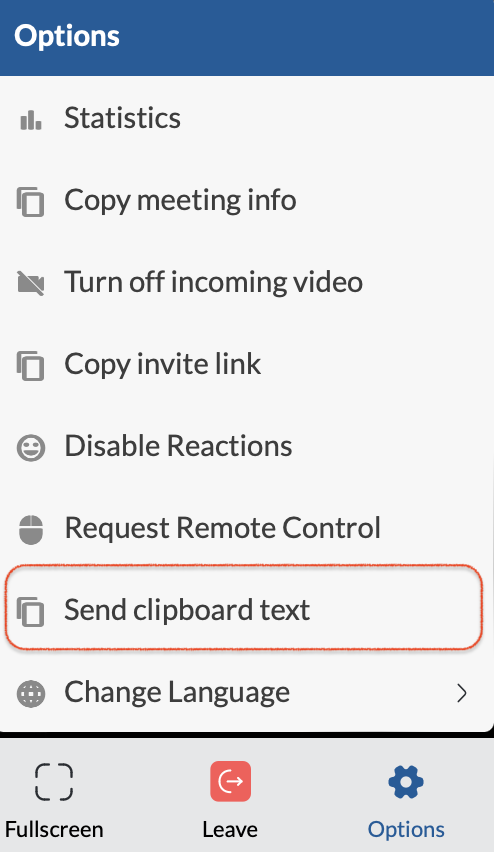
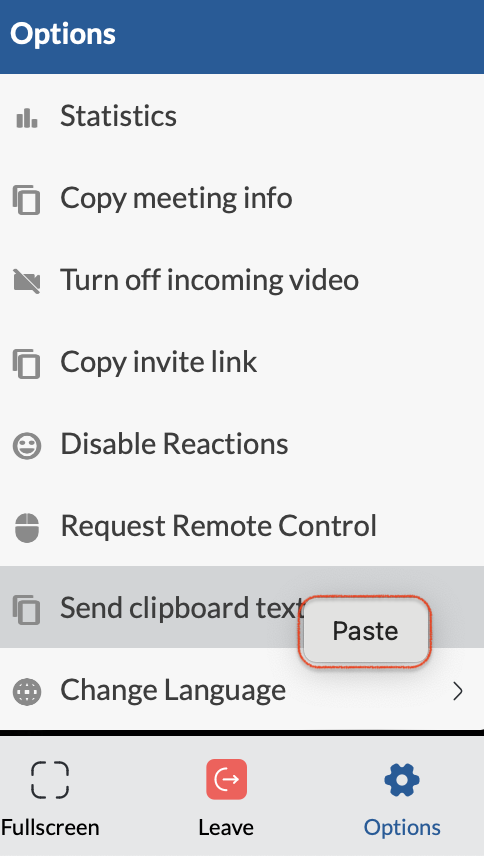
Firefox web browser
The Firefox web browser does not support clipboard sharing.
Note: The presenter using the web application cannot grant remote control or enable clipboard sharing for web or desktop users. In other words, it is not possible to take control of someone's computer or access their clipboard if they are participating in the meeting via the web app. Only presenters using the desktop app can grant remote control and enable clipboard sharing for web and desktop users.
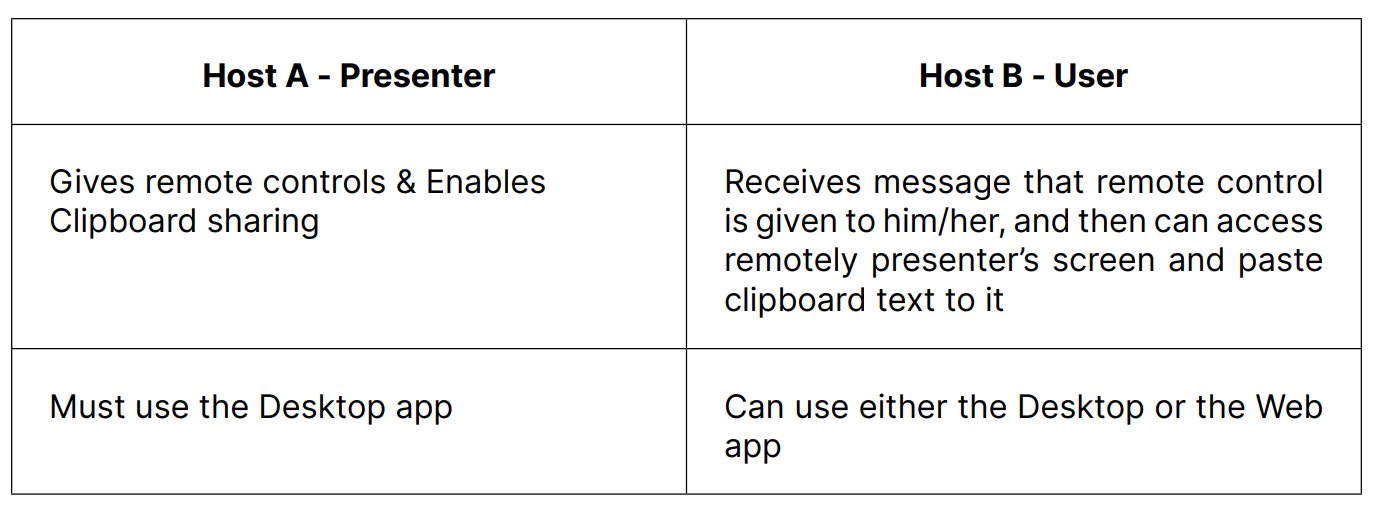
¶ Raise Hand
The Raise Hand feature is a straightforward option to catch a speaker’s attention without interrupting them or disrupting an online meeting. Users can access it from the main Meeting toolbar. The participants’ Raised hands are displayed in the upper left corner of their video stream on the Meeting screen (both in carousel and grid view), and in the Participant list next to their names.
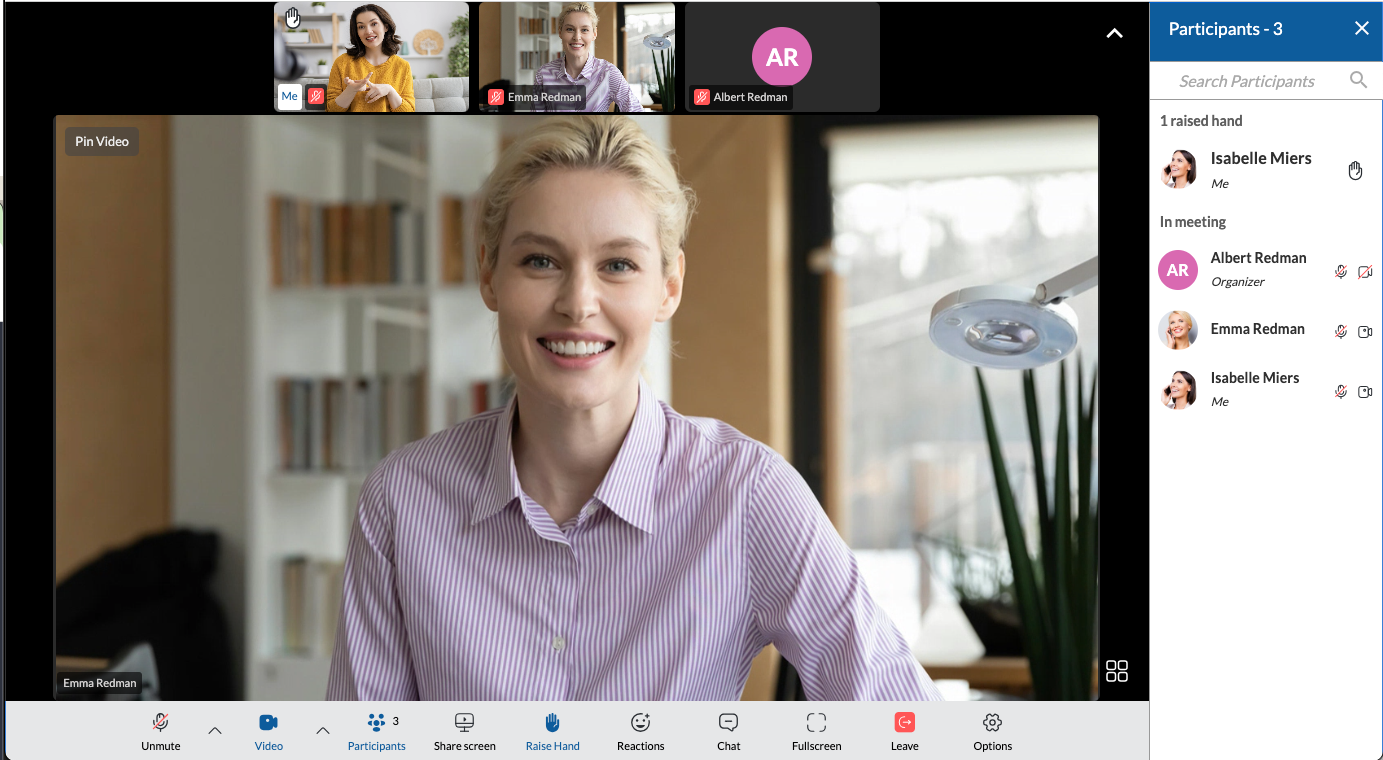
The Organizer and Co-organizers using the web app are able to lower the Raised hands of other participants by clicking on the “Raised hand” icon next to the user’s name on the participant list.
¶ Reactions
In-meeting reactions allows users to visually express themselves during the meeting by using a variety of emoticons like laughing, celebrate, applause and similar in real time.

Users can access this feature by clicking the Reactions icon in the Meeting main toolbar. This will open the Reactions menu, allowing the user to choose which emoticons to use. When the user clicks a certain reaction, an animated version of the icon will float upwards from the left side of the screen. The name of the sender is also displayed below the reaction. Presenters are not able to see the reactions they get while they are sharing their screens, these reactions will now be summarized and displayed after screen sharing has finished. The presenter will receive a notification message that contains all received reactions. The message is displayed at the bottom of the meeting screen, just above the toolbar; as soon as screen sharing has stopped.
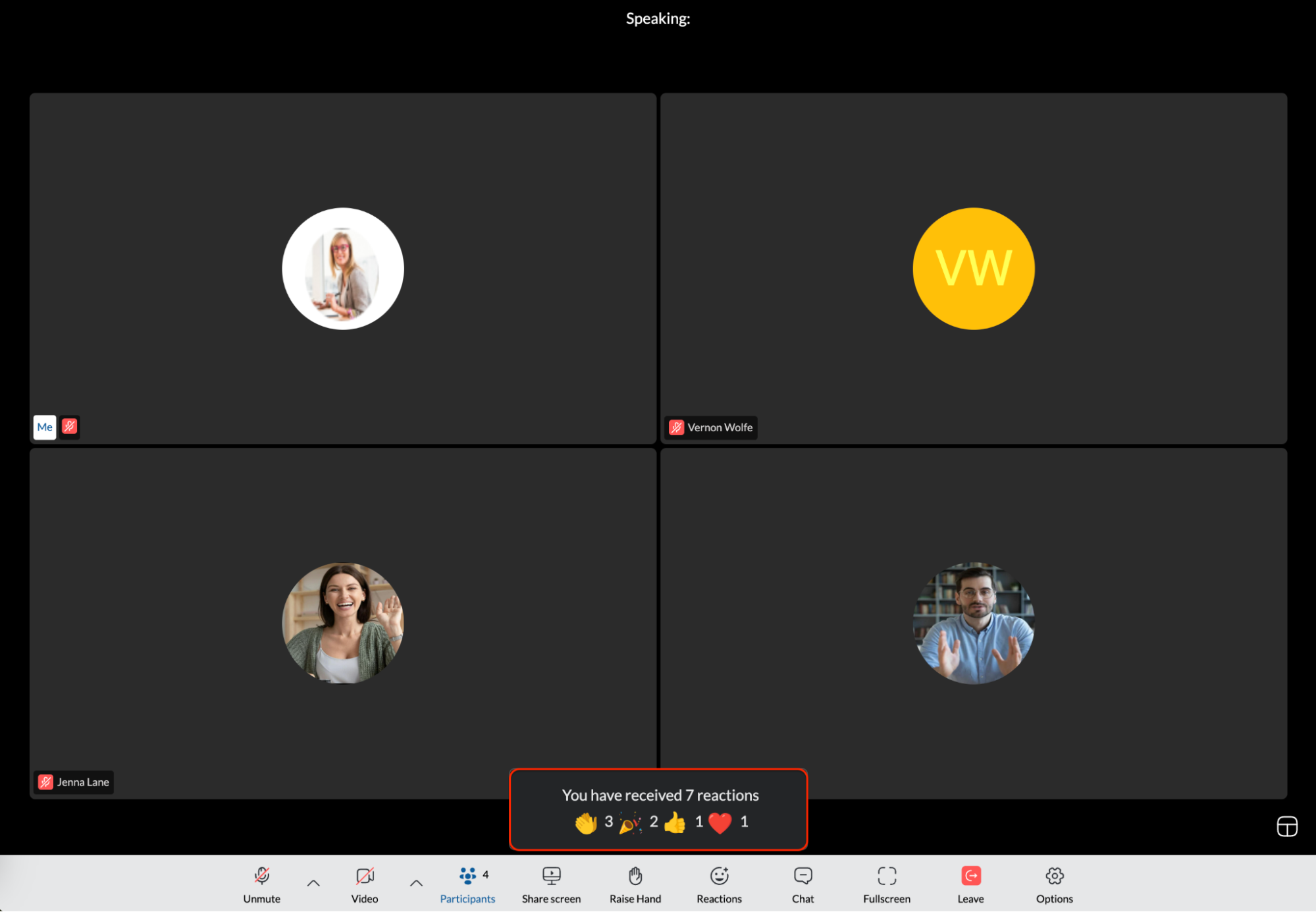
Besides this message, If a web user allows notifications in the web browser for the Meeting site, the user will also get a web browser banner notification in the upper right corner indicating that reactions have been received.
To prevent feature abuse, only a few reactions can be sent at any given time.
If the user wants to hide others’ reactions, they can do so by clicking the “Disable Reactions” option under the Options button on the main Meeting toolbar. Reactions are enabled by default.
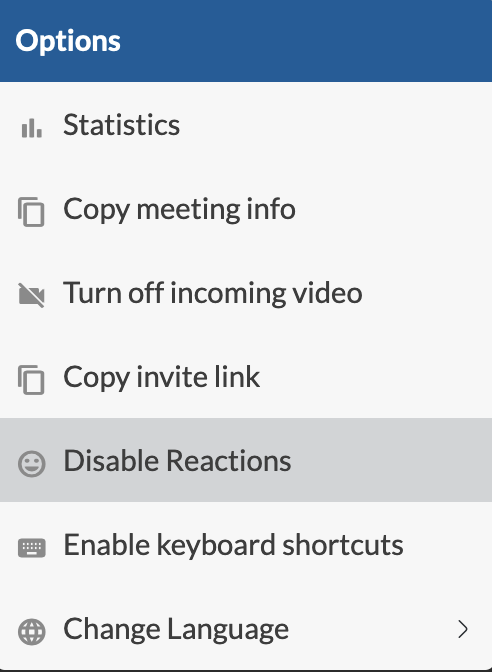
¶ Chat
![]()
The in-meeting chat allows users to send and receive messages in real-time with other participants.

Along with text, users can share files and use emojis to enhance communication. The chat supports previews for various image formats, including PNG, SVG, JPG, and more. Unsupported image formats, like ICO, will display a generic image icon while non-image files will show a file icon.

¶ Fullscreen
![]()
The user can make their screen expand to get a better view of the other video participants.
¶ Leave
![]()
The user can press this button to remove themself from the meeting. Once the user clicks on the button they will be prompted to confirm their departure from the meeting.
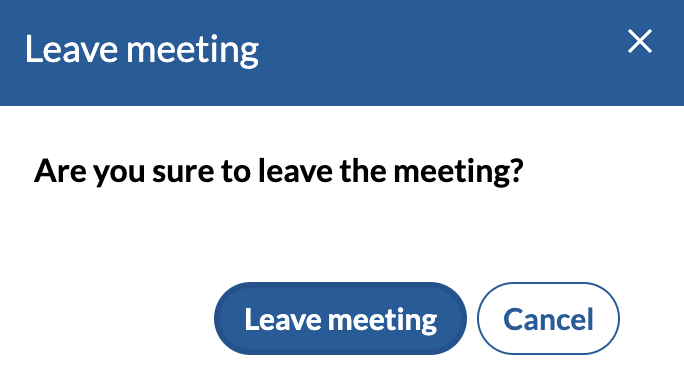
¶ End Meeting
When a user joins a meeting as an organizer or co-organizer from the web app, they will see an End Meeting button instead of the usual Leave Meeting button in the main toolbar. Upon clicking it, a dialog box will appear with the following options:
- Leave Meeting – to exit the meeting without ending it for others.
- End Meeting – to end the meeting for all participants (newly added option).
- Cancel – to return to the meeting without making any changes.
Only organizers and co-organizers will have an option to end the meeting
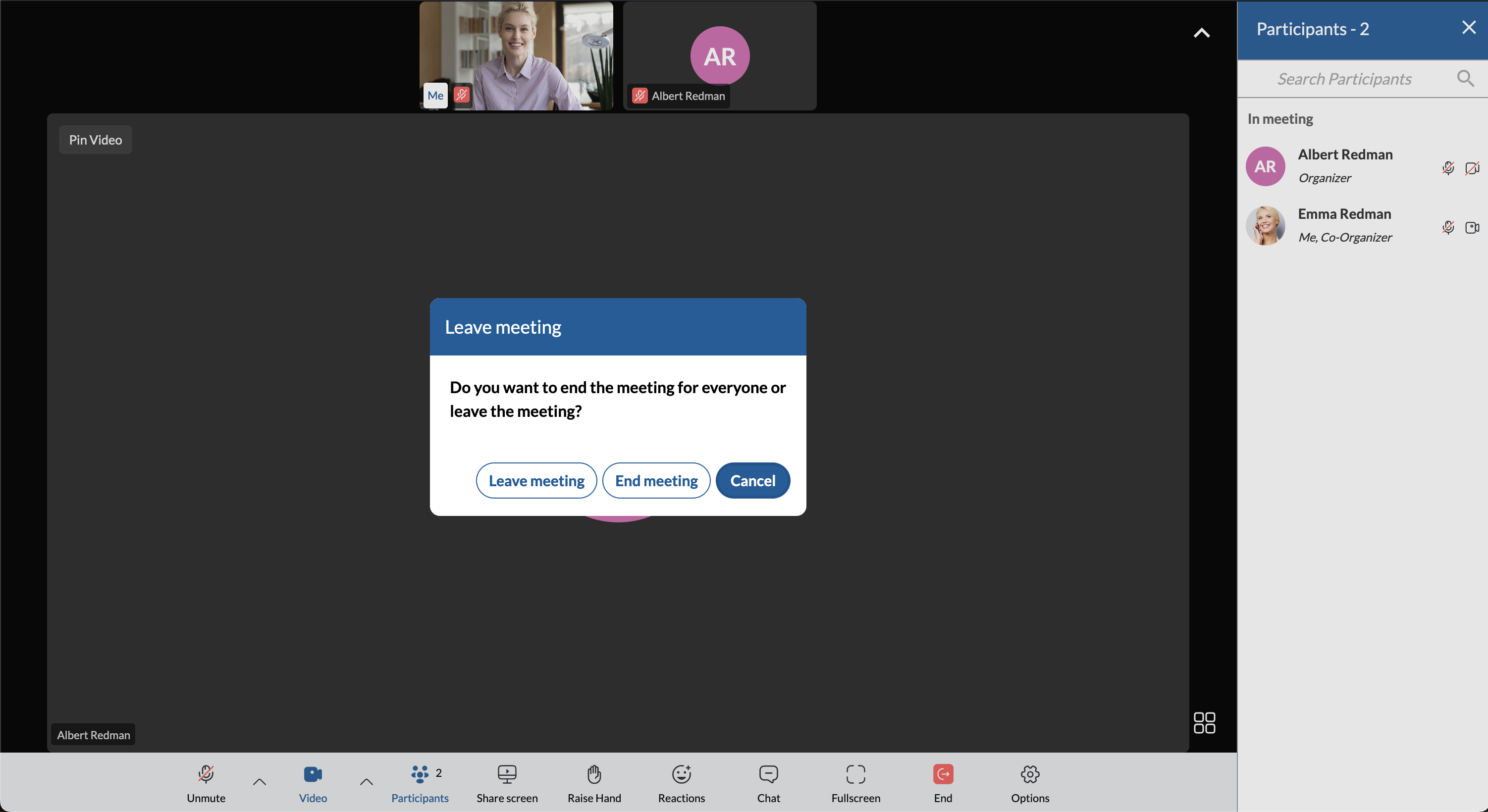
¶ Options
![]()
Once you click on options you will have these points of interest:
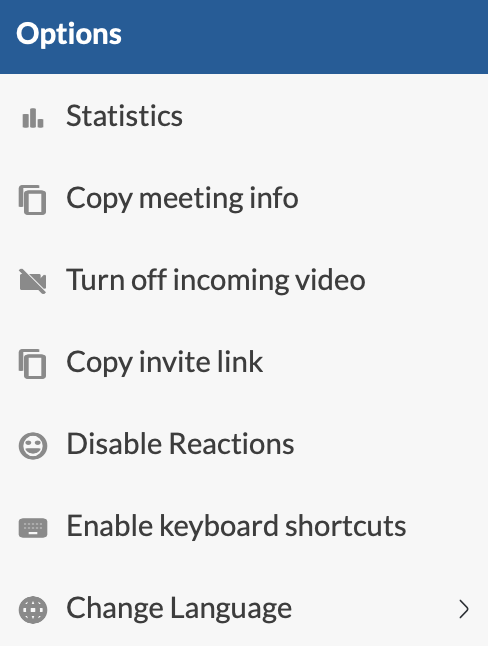
- Statistics allows user to to monitor and show network connection quality using following parameters: latency, jitter, packet loss and bitrate
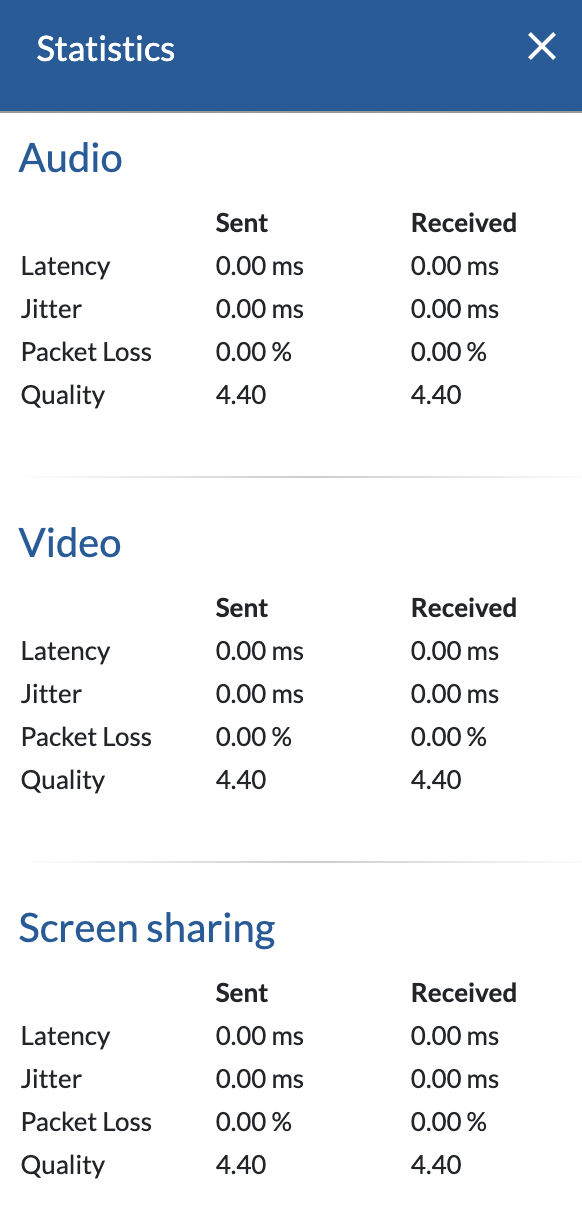
- Copy invite link will copy the link to join the meeting to user’s clipboard
- Copy meeting info allows user to copy the meeting number
- Turn off incoming video will turn off all active video from other participants
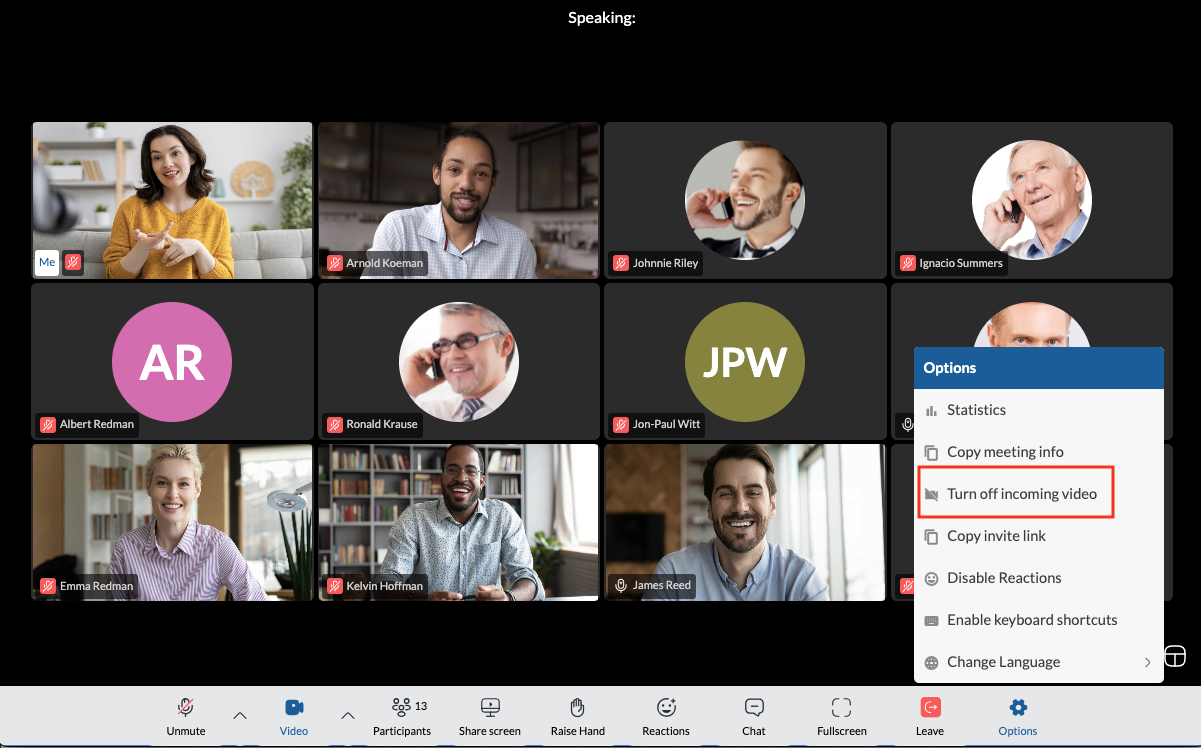
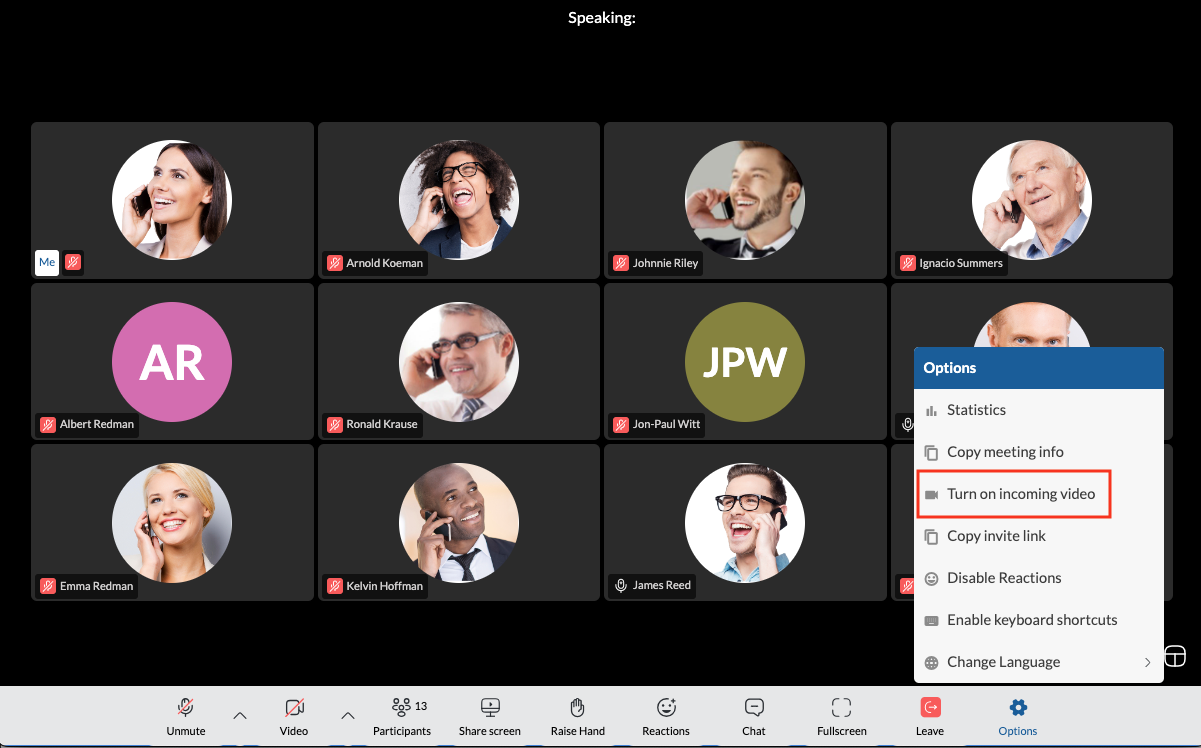
- Disable Reactions If the user wants to hide others’ reactions, they can do so by clicking the “Disable Reactions” option under the Options button on the main Meeting toolbar. Reactions are enabled by default.

- Request remote control option allows the user to request access to control the current presenters screen.This option is only available when another meeting participant is sharing their screen.
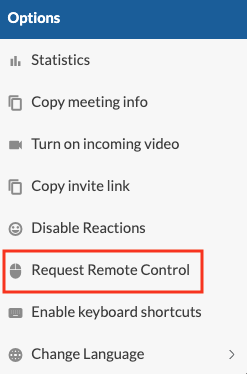
- Keyboard shortcuts In order to use the Keyboard shortcuts, users should first enable this function in Options by pressing the Enable Keyboard Shortcuts option.
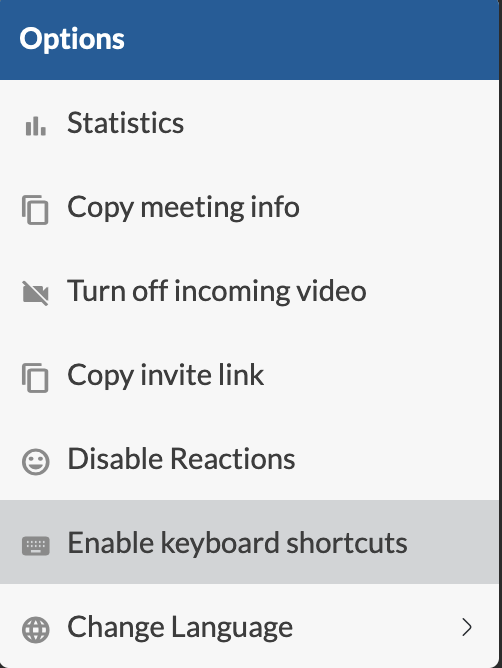
Once enabled, shortcuts will also appear when user hovers over the buttons in the control bar.
- Alt + A - Mute/Unmute microphone
- Alt + V - Turn Camera on/off
- Alt + U - Toggle Participants list on/off
- Ctrl + Alt + H - Raise/Lower Hand
- Alt + H - Toggle Chat on/off
MacOS users, instead of the Alt key should use the Option key.
Shortcuts will only work when the meeting screen is in focus
- Translation allows users to change language during the Meeting, the user should choose the Change Language option from the Options drop-down menu in the meeting main toolbar. A list of available languages will be displayed, and the user can select the language that they would like to use. As soon as the user chooses a new language, all buttons, pop-up messages, etc in the meeting web app will be translated.
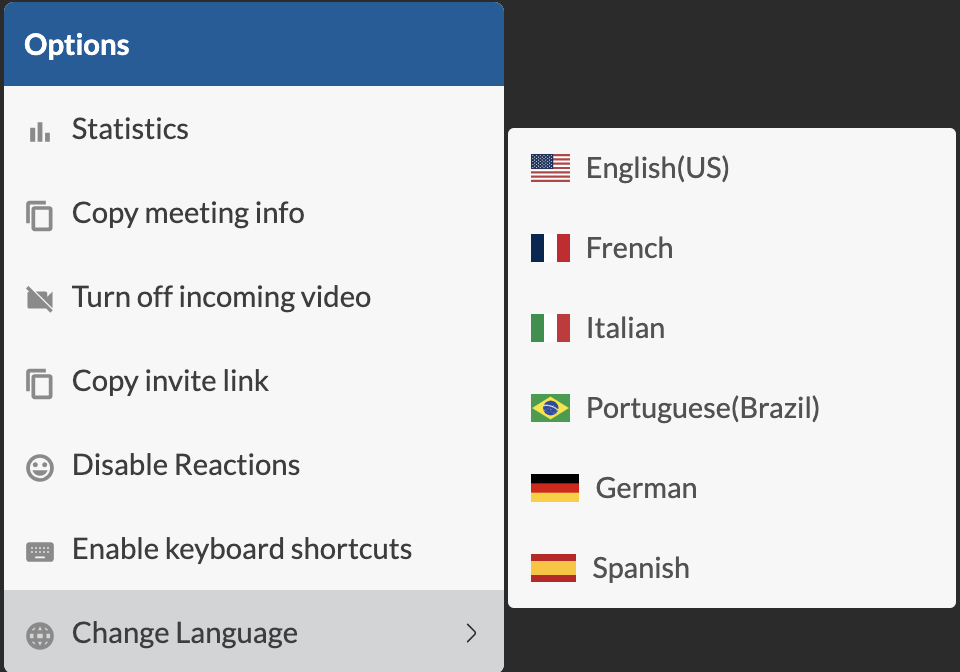
¶ Multiple meeting co-organizers
Meetings can include multiple Co-organizers. When Co-organizers join via the web app, they will have a "Co-organizer" tag displayed in the participant list. They are granted special permissions, such as the ability to lower the raised hands of other participants and to end the meeting.
¶ Bad internet connection indicator
If the user’s internet connection is poor to the point where it affects the audio and video quality of the joined Meeting, the following notification will be displayed in the upper left corner of the meeting screen:

¶ Pre-expiry notification
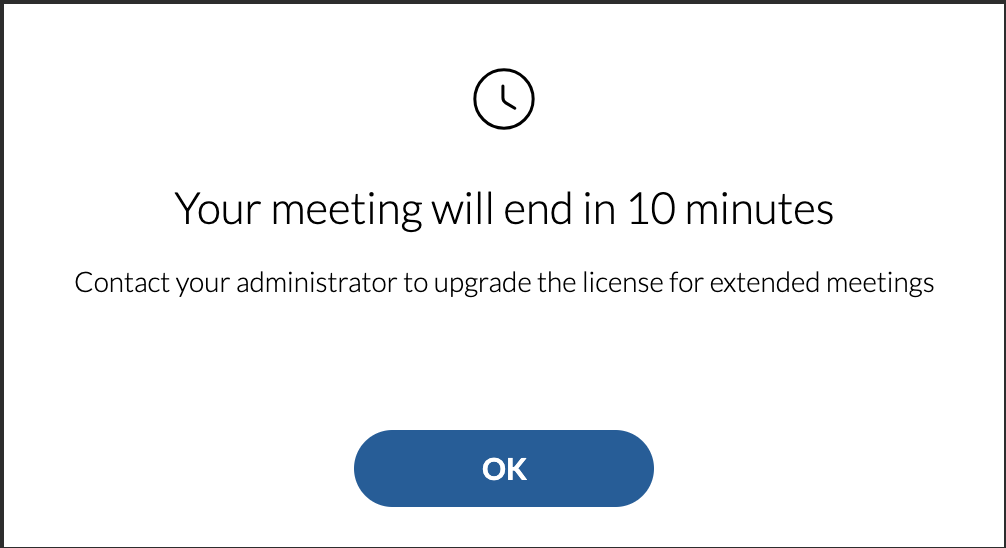
Pre-expiry notification is a feature designed to automatically send a notification to all meeting participants ten minutes before the end of the maximum meeting duration based on the type of license/package. This notification serves as a gentle reminder that the meeting is approaching its conclusion. If the message is not closed, it will automatically count down the time until the end of the meeting. Also, if someone joins the meeting less than ten minutes before the end, they will get a message with the exact time remaining for that meeting.
Note: This message appears only on the Meeting screen!
But, if a web user participant allows notifications in the web browser for the Meeting site, they can get a banner notification message in the upper right corner indicating that the Meeting will end in 10 minutes. After that, the user can switch to the Meeting screen and see the original message. This way, the user does not have to be on the main meeting tab to be informed about the end of the meeting. They can be on another web browser, doing something else on their machine and even have the Meeting web browser tab minimized, etc.